3 Days in Florence: A Perfect Itinerary for First Timers
You’re in for a treat: Florence’s history is equal parts fascinating and salacious, with plenty of stories full of backstabbing and allegedly celibate religious figures with multiple sons that wouldn’t be out of place on a show like Game of Thrones.
The rich and sometimes salacious history around the Medici family, one of the most famous families in Florence’s history, is worth learning about. And I do mean “rich” in multiple ways.
The story of the Medici Family, in particular, is one that you should seek out, mostly because you’ll see the indelible imprint they left on the city of Florence around every corner while you’re in the Tuscan capital.
The thing that always stands out to me about Florence, though, is the opulence and architectural flair that you see as you’re walking around.
At one time Florence was the banking capital of Europe, and was where the first gold florins that were later used as international currency were minted. Florence was, like, a big deal.
Florence wasn’t rich because it had a lot of art. It was, in fact, it was quite the opposite.
The sheer amount of wealth that flowed into Florence during the 14th and 15th centuries (largely due to the reputation of Florence’s textiles) is mind-boggling, and is a big part of the reason why it is one of the most visited cities in Europe half a century later.
That wealth allowed the noble families of Florence (like the Medici, who were patrons of Michelangelo) to commission some of the most beautiful art in Europe and, in a fashion, enable the Renaissance to take place.
In this guide to planning your trip to Florence, you’ll find a detailed 3 day Florence itinerary, complete with things to do, see, eat, and drink, along with the important details you need to know to have a memorable trip.
You’ll also find logistics – like how to get around and some useful tips and tricks for visiting Florence – that are important for planning your trip.
We hope you enjoy this guide, that you find it helpful for planning your trip, and we help you discover something new and exciting, whether it’s your first time, or tenth.
Sound good to you? Let’s get into it.
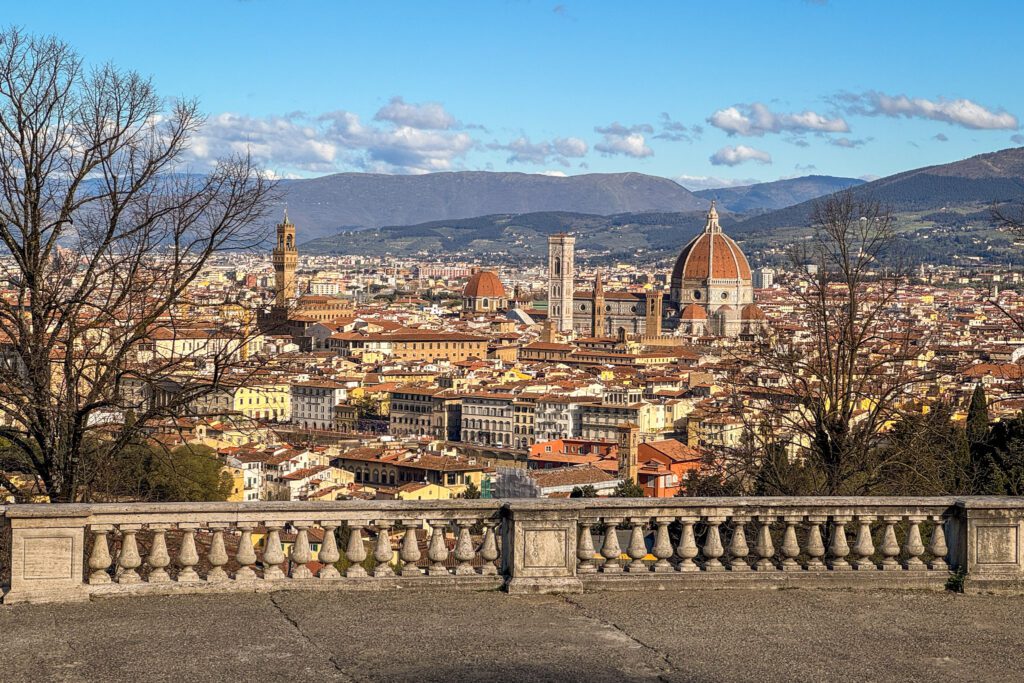
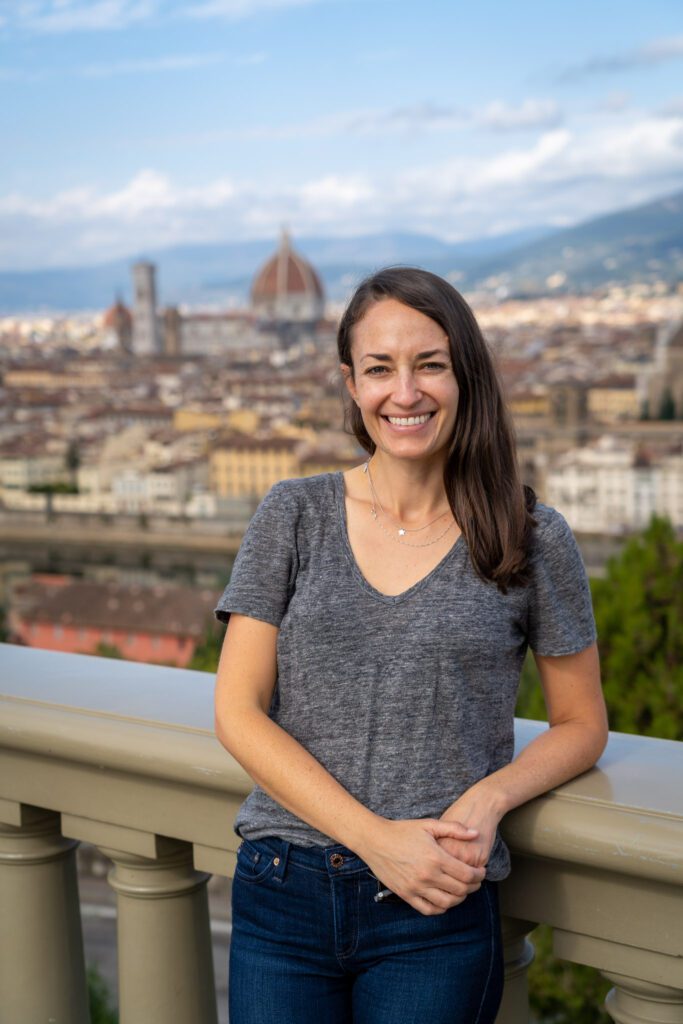
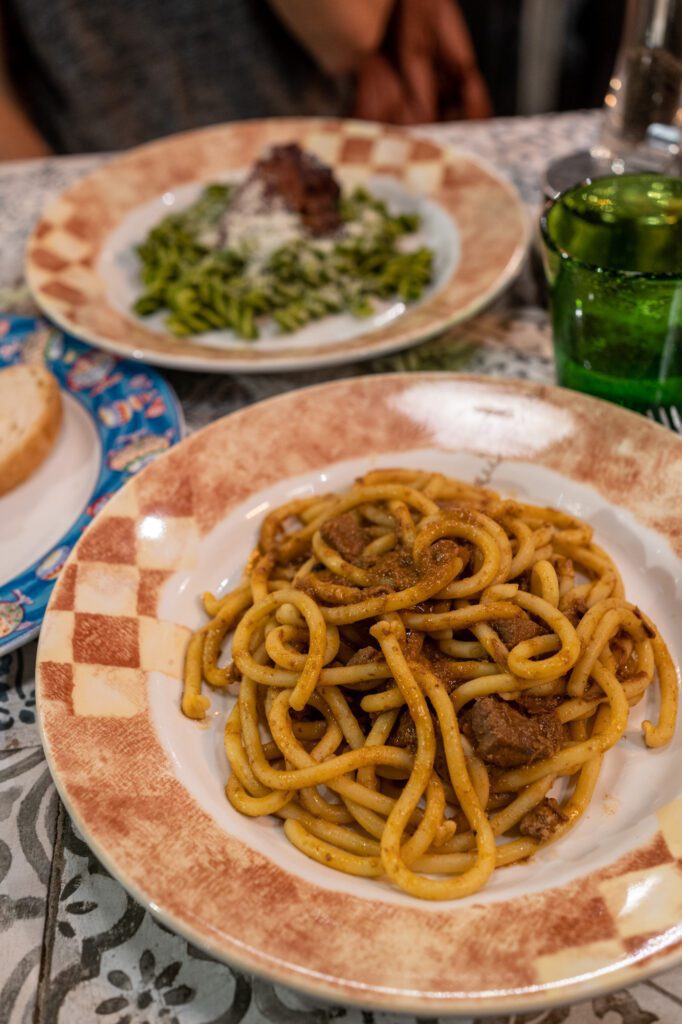
Disclaimer: Some of the links in this post, like hotel links, are affiliate links, meaning at no additional cost to you, we make a little bit of money if you click through and book. That being said, we would never recommend something to you that we don’t stand behind 100%.
How Much Time to Spend in Florence?
There are a couple of considerations that we’re trying to balance when we choose how many days to recommend in a city.
On one hand, we want to make sure that you have enough time to get a feeling for what makes the place special, which almost always means AT LEAST two days in any city.
On the other hand, we also want to be cognizant of limited vacation time, so while we absolutely would love to recommend you spend a week exploring a city, it’s not particularly practical for most visitors.
We think that Florence itself is worthy of at least two days.
The historic center of Florence – which is the part you’ll be focused on as a visitor – is relatively compact compared to, say, Rome or Milan, and two days will allow you to break up the main sights so that you’re not doing multiple major attractions in the same day (which is exhausting).
However, one of the things that we think makes Florence special is the fact that it is a top-tier Italian city when it comes to the number of day trip opportunities.
Want to feast on filled pastas, prosciutto, and parmesan? Bologna is a 45 minute high speed train ride away. Want to dive into one of the most prestigious wine regions in the world? Chianti is 30-45 minutes away from Florence.
That’s why we think you should add at least one extra day in Florence to take advantage of Florence’s strategic location (we’ll cover in the itinerary below what we would do with that day), which brings us to a total of three days.
We have a strong recommendation here: Don’t try to do a day trip if you only have two days. We really do think you need two days for Florence itself, and doing a day trip means you’re going to short change your exploration.
Where to Stay in Florence
As major Italian cities go, the historic center of Florence is a relatively small amount of ground to cover.
Staying in any of the areas we recommend in our guide to the best areas to stay in Florence will put you within walking distance of most of the city, which is great!
However, there are two areas that we think are a cut above the rest – the historic center (near the Duomo and Piazza della Signoria) which is all charm and gorgeous architecture, and Oltrarno, which is the neighborhood just across the river that is full of great places to eat and drink.
The decision point essentially comes down to budget and what kind of experience you’re looking for (if you’re on a budget, we’d look at San Marco, which is the northern edge of the historic center and tends to lean more budget-friendly).
The Centro Storico: The Heart of All the Action
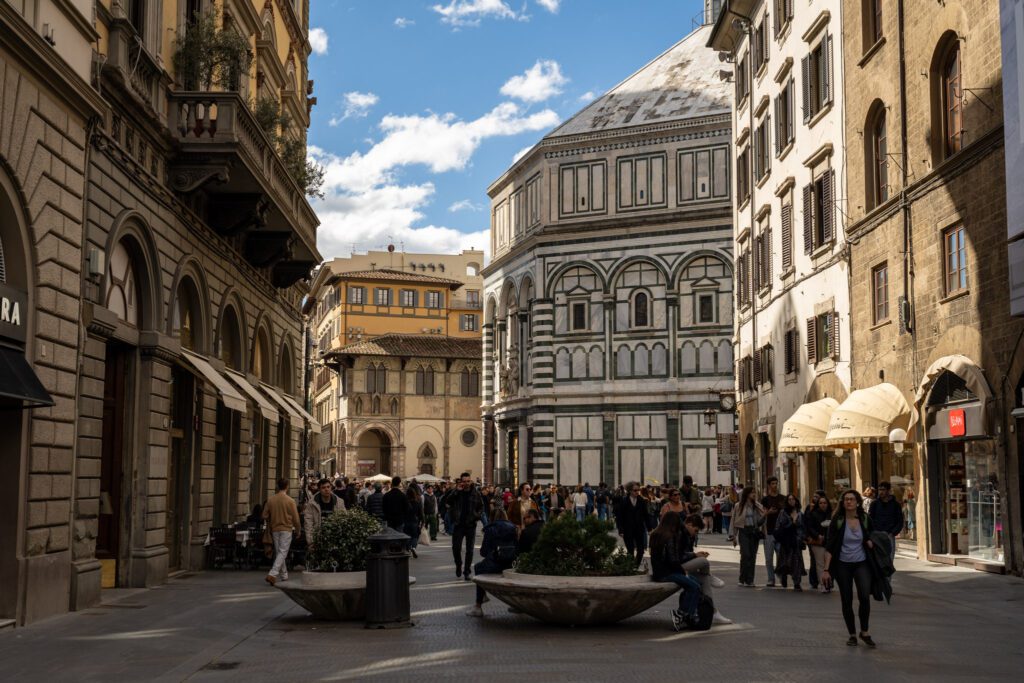
On my latest trip to Florence (in the spring of 2025), I was with my mom and uncle (a first timer in Italy despite being named “Pasquale”) and I decided that we should stay in the historic center for full immersion.
Later in the trip, I turned to my mom and remarked that we literally could not have stayed any more centrally (we were at Condotta 16, which is right off of Piazza della Signoria).
The part of the historic center between the Duomo and Piazza della Signoria is charming, central, and a lovely home base for exploring the rest of the city.
It puts you within walking distance of just about everything – the Duomo and Piazza della Signoria (along with the Uffizi Gallery and Ponte Vecchio) are within 5-10 minutes on foot.
The tradeoff is, you guessed it, price – it’s the most expensive part of the city, but you’re paying for the location and vibe of being in the heart of all the action, present and historical.
For the purposes of this guide, we’re consolidating everything from San Lorenzo, which is at the northwestern edge of the neighborhood near the train station, down past the Duomo to the Arno River and Piazza della Signoria.
It’s a relatively big area with pockets that look and feel slightly different, but at the end of the day will all offer a relatively similar experience for visitors to Florence.
The main benefit of staying here is full immersion in the opulence of Florence. The architecture is gorgeous, and we still marvel at Brunneleschi’s Dome every time we lay eyes on it.
Here are a few places that stood out to us in the historic center.
Condotta 16: We stayed here on that latest trip to Florence and loved both the location and the apartment. We were a group of three, and wanted a two bedroom apartment with a little more space rather than getting multiple hotel rooms for the group. We chose Condotta 16 for the location (it’s one block from Piazza della Signoria, and five minutes to both the river and the Duomo), but were pleasantly surprised at how nice the apartments were. Highly recommend if you’re looking for an apartment-style room in central Florence.
The Artists Palace: A nice, newly renovated hotel inside a former palazzo that looks out on the Basilica di San Lorenzo, mere blocks from Piazza del Duomo and a short walk from the train station. A truly excellent location.
Oltrarno: Our Favorite Part of Florence
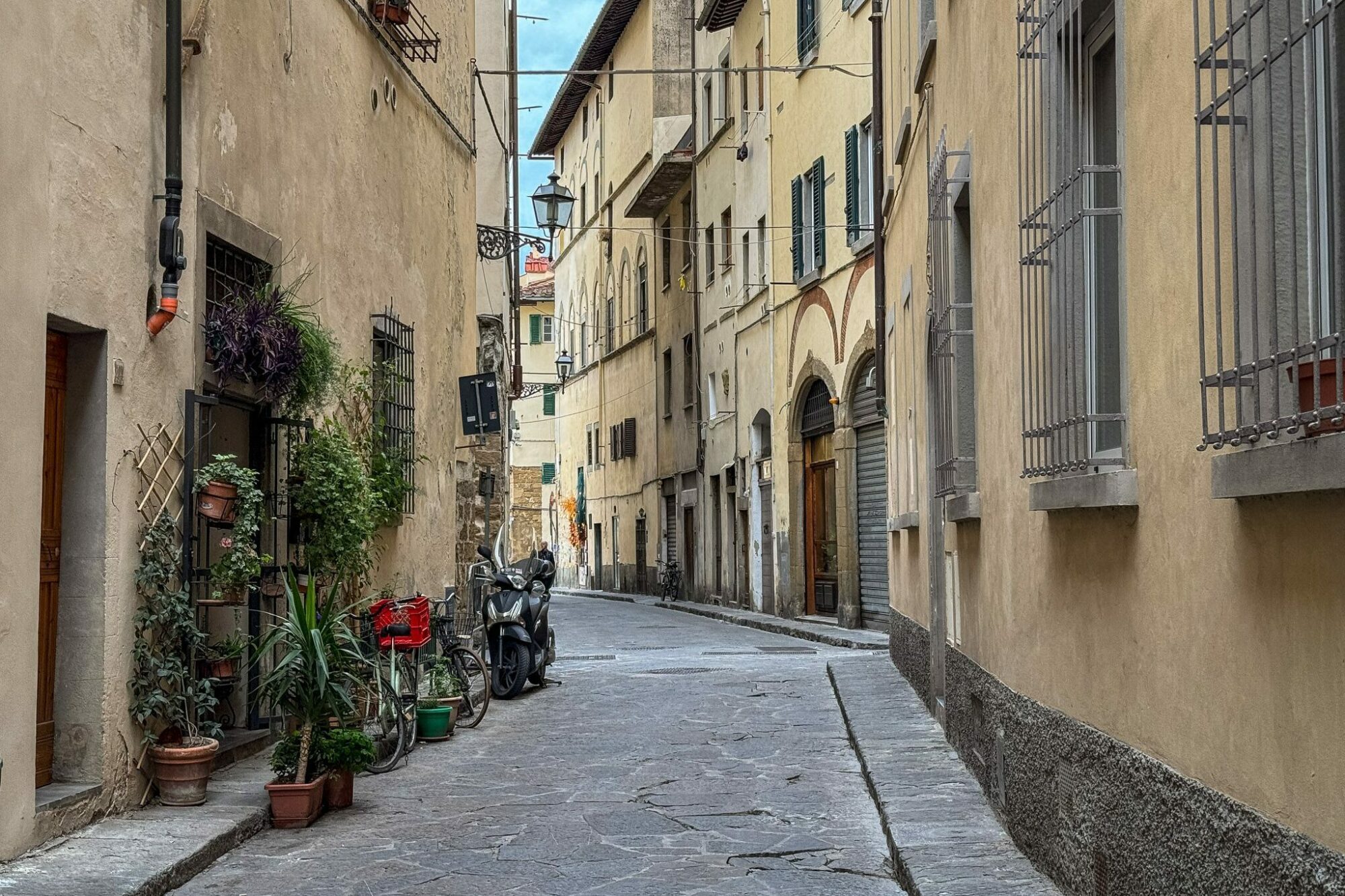
Every trip to Florence, we’re reminded that our favorite part of Florence is actually not the historic center near the Duomo (which is obviously lovely), but just across the river near Piazza Santo Spirito.
The area across the river – called Oltrarno – offers a slightly quieter slice of local life in Florence that is removed from the majority of the hustle and bustle that you find in the center (though, it’s still central Florence, so there will be people around).
The tradeoff here is the location, but the thing to remember is that Florence is a compact city, and you will be able to walk from your hotel in Oltrarno to the Duomo (across Ponte Vecchio, the famous bridge) in about 15-20 minutes.
The other thing to know is that there aren’t a ton of places to stay in this part of the city, partially because it’s so residential, which means prices aren’t going to be as low as you’d hope based on the description I just gave you.
Many of our favorite places to eat and drink – including one of our favorite wine bars, one of our favorite coffee shops, and Alysha’s favorite gelato – are in this part of the city, along with the scenic walk up to Piazzale Michelangelo (and beyond – more on that below) that is going to be a staple of this itinerary.
Here are a few places to stay in Oltrarno that caught our eye.
FuordArno B&B: I’ve wanted to stay here for years, but every time I look it’s either sold out, or something about timing doesn’t quite work out. It’s a tiny bed and breakfast – and that does mean that breakfast is included in the room rate – along the south bank of the Arno River, a few minutes away from Santa Croce (and a short walk up to Piazzale Michelangelo). It’s a quieter location than staying on the other side of the river, but it’s so close to the river that it’s still plenty central.
Casa Botticelli: This boutique hotel is up the hill near Palazzo Pitti and the Boboli Gardens, which puts you a short walk away – less than five minutes – to Piazza Santo Spirito and the heart of the neighborhood. In terms of amenities, this hotel has a bunch of nice add-ons, including breakfast included in the price of your room and free coffee, tea, and snacks.
AdAstra Suites: Removed from the hustle and bustle of the heart of Oltrarno, AdAstra Suites is on a garden southwest of Santo Spirito, which means it IS a longer walk to basically everything on your Florence itinerary, but it also means that you’re in a much more relaxing atmosphere that almost feels like you’re not in one of the most heavily visited cities in the world. The hotel is in a renovated mansion that has a gorgeous wrap around terrace, which overlooks the gardens and is where breakfast is served (it’s included in the room rate). There are four rooms that open straight out onto the terrace, and the “King View” rooms have EXCELLENT views out onto the gardens.
3 Days in Florence: A Complete Itinerary for First Timers
And now, let’s get into the meat of the itinerary with all of our thoughts about how to organize your (limited) time in Florence to make the most of it.
One of our favorite parts about Florence is that it serves as a fantastic home base for exploring the surrounding area of Tuscany. On your third day in Florence, we highly, highly recommend you take a day trip either to Lucca, Bologna, or the wine region of Chianti (though those certainly aren’t the only options).
Here’s an overview of the itinerary you’ll find below:
- Day 1: Brunelleschi’s Dome, an Introduction to Florence, and Oltrarno
- Day 2: The Uffizi Gallery, Santa Croce, and a Foodie Adventure
- Day 3: Choose Your Own Day Trip Adventure
For this itinerary, we’ll assume you’re arriving the evening before and have three full days to explore, but you’ll have to massage things to fit your own particular timing.
One important note at the top of this guide: We’re putting the Galleria dell’Accademia di Firenze (where you’ll find the David) in the “with more time” section, which is probably a controversial decision, but hear us out (and also, we have ideas on how to swap it in if it’s a can’t-miss for you in a second).
Two days for Florence itself is a pretty limited amount of time, and we found ourselves struggling to find a good place to put it.
If we had to choose two of the three major attractions in Florence – the Duomo complex, the Uffizi Gallery, and the Accademia – we’d absolutely choose the first two (which is reflected in the itinerary below).
Given that we usually don’t recommend multiple big attractions in one day and the fact that you only have two days, we decided to move it to the “more time” section.
We were, essentially, having to choose between the third museum and things like exploring our favorite neighborhoods and diving deeper into the excellent food scene in Florence, and we think your time is better spent on those deeper experiences.
Plus, there’s a replica that you can see for free in Piazza della Signoria (which is the original location of the statue, before it was brought inside for preservation).
If you do want to do it, you’ll need to book as early as humanly possible (or do a guided tour) and swap it in for either the walking tour with Andrea or the food experience sections.
You can find more information on the logistics in the “more time” section.
Day 1: Brunelleschi’s Dome, an Introduction to Florence, and Oltrarno
On your first day in Florence, start with the centerpiece of the city – the Duomo di Firenze – and then learn about Florence’s rich and fascinating history on a walking tour before ending your day across the river in Oltrarno, where you’ll find our favorite view of the city.
The Duomo Di Firenze & Brunelleschi’s Dome
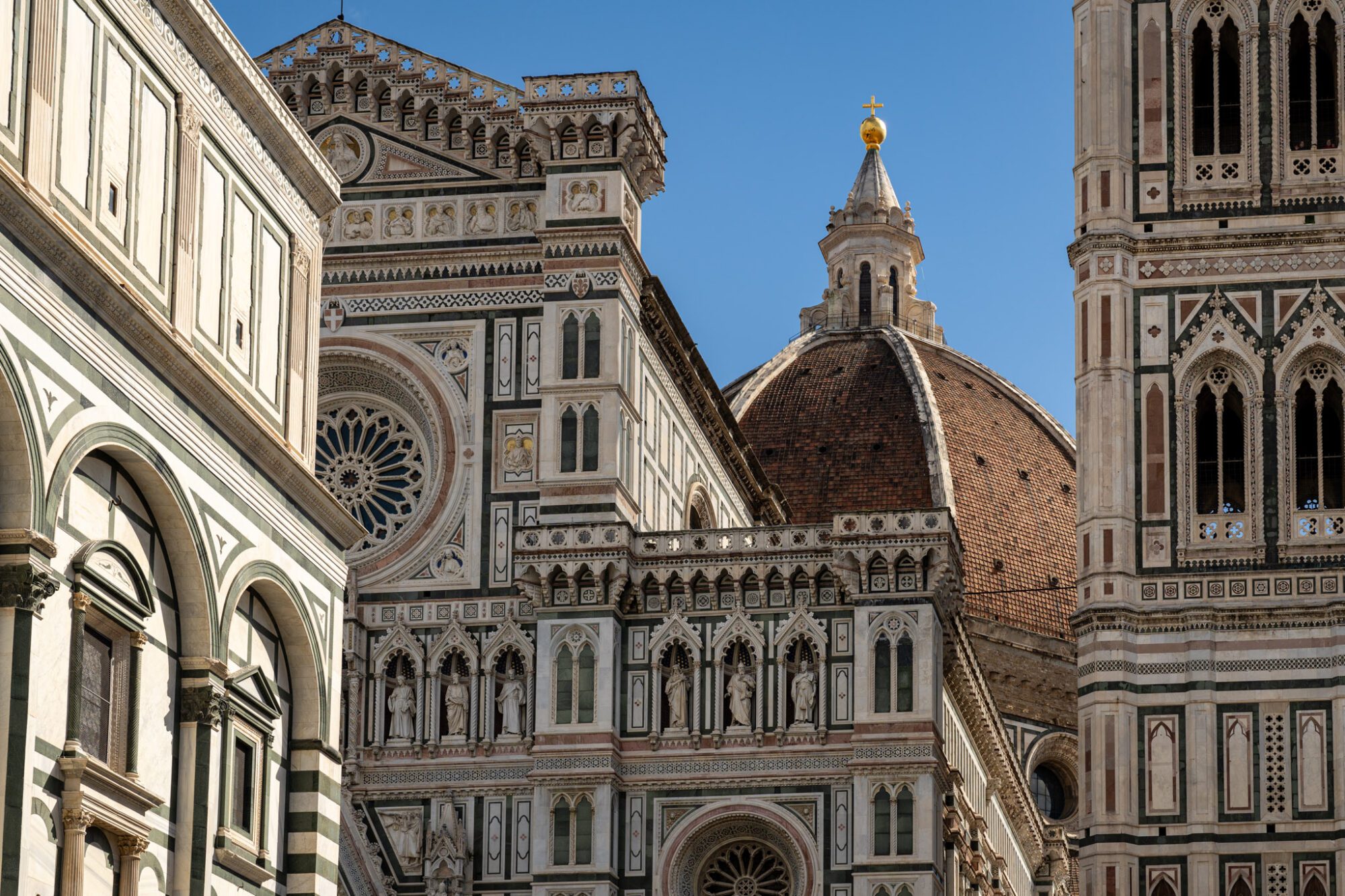
The Duomo di Firenze (also known as the Cattedrale di Santa Maria del Fiore) is the centerpiece of Florence’s historic center.
Even to this day, my jaw still drops a little bit when I turn a corner and see the marble facade (or the red bricks of the dome) of the massive church looming ahead.
The first thing you need to know here is that the Duomo is really a complex, with five different pieces that you could visit.
They are the bell tower (the Campanile di Giotto), the Museum, the Baptistery, the church interior, and Brunelleschi’s Dome (which means climbing to the top).
While you could spend your entire day running around to see every piece of that complex, we have some thoughts on how to streamline things.
At a high level (we’ll get into more detail in the sections below), we think that you should focus your time on a couple of the aspects of the Duomo: climbing the dome, the Baptistery, and maybe the Duomo Museum (where you can see the original Baptistery doors, among other things).
Here are our brief thoughts on the other parts of the complex (and why we’re not covering them in the itinerary)
- Giotto’s Campanile (the bell tower): Not worth the climb if you’ve done the dome, we think. However, the climb to the top is significantly less claustrophobic, so it could be worth it if that’s the piece of the dome climb that concerns you. It’s a less sweeping view of the city and surrounding landscape, but you do have a nice view of the dome.
- The Interior of the Church: After seeing several other churches in Florence on this latest trip (including the Duomo), the interior of the Duomo was our least favorite. Add to that the fact that, because it is free to enter, there are often HUGE lines winding their way around the piazza, and we’d say to spend your time on the other churches (namely Santa Croce and Santa Maria Novella), which we think are better uses of time (though they do cost money).
Climbing Bruneleschi’s Dome
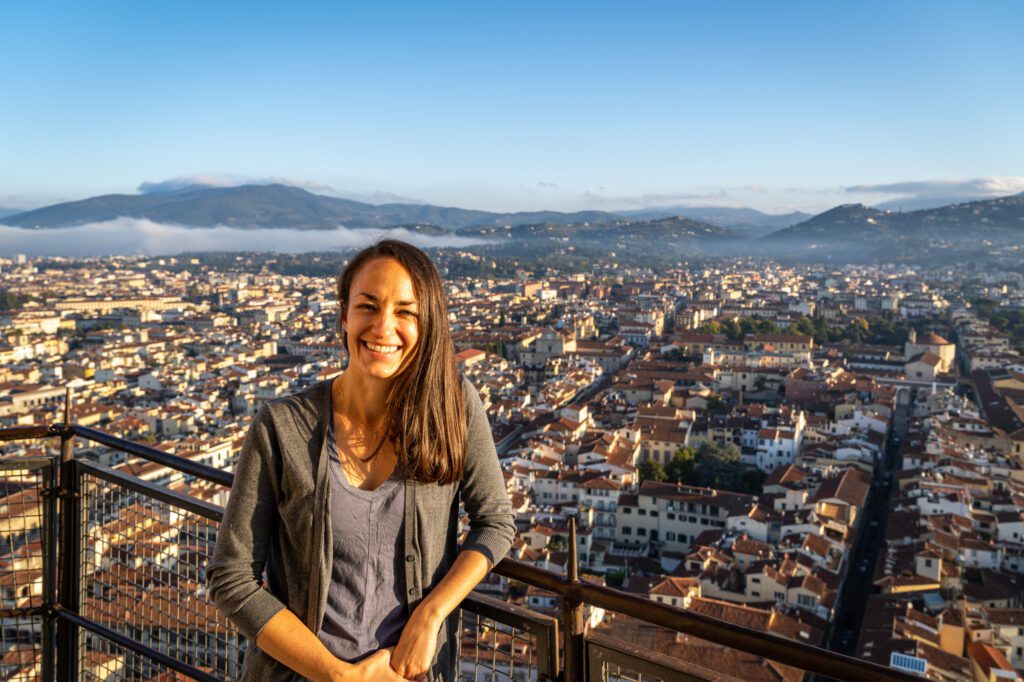
We think the best aspect of the bunch is Brunelleschi’s Dome, and we say that for a couple of reasons.
First, the view from atop the dome is pretty spectacular. It gives you a bird’s eye view of the city and surrounding landscape, and is our favorite view in Florence.
Second, the view of the art on the interior of the dome is second to none, because you traverse a passageway along the base of the the inside of the dome to reach the top, which gives you an up close and personal view of the creatures that were created to depict what happens when you get to the Day of Judgement (the event that the art is depicting).
There are depictions of heaven and hell, and some of the figures in the hell portion really make me wonder exactly what drugs artists back then were taking. The imagination that went into creating this piece is truly wild.
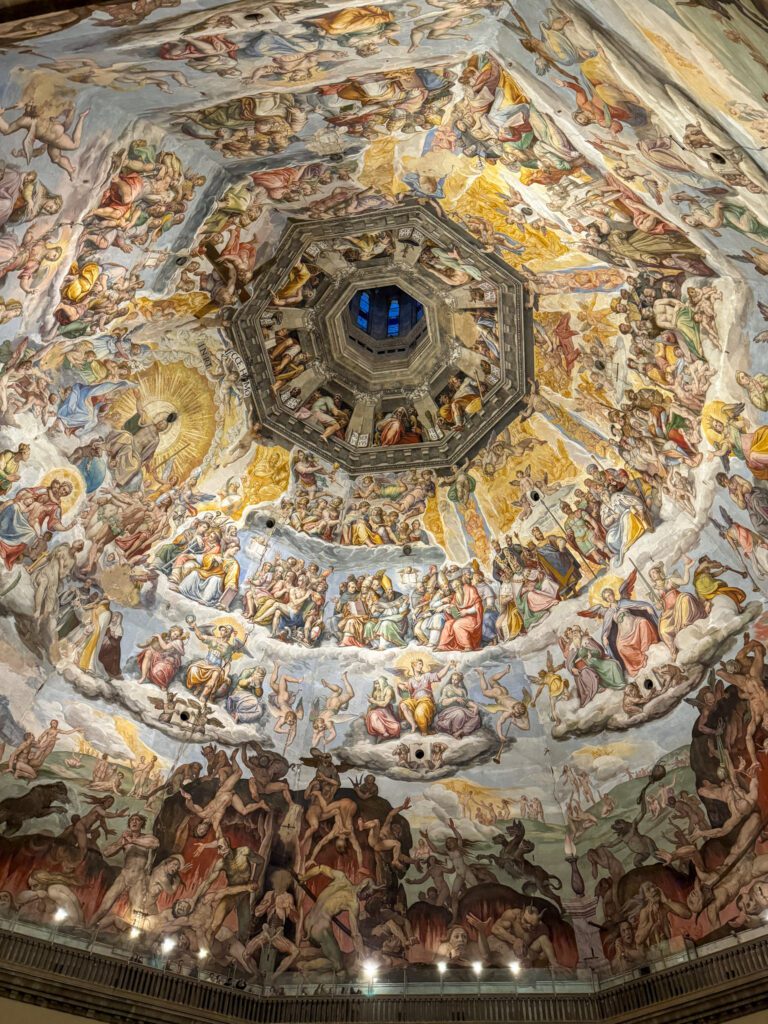
Last, but certainly not least, the climb gives you a unique perspective on the construction of the dome.
It’s actually two domes – one outer, one inner – and to get to the top, you climb in between them, which is pretty interesting.
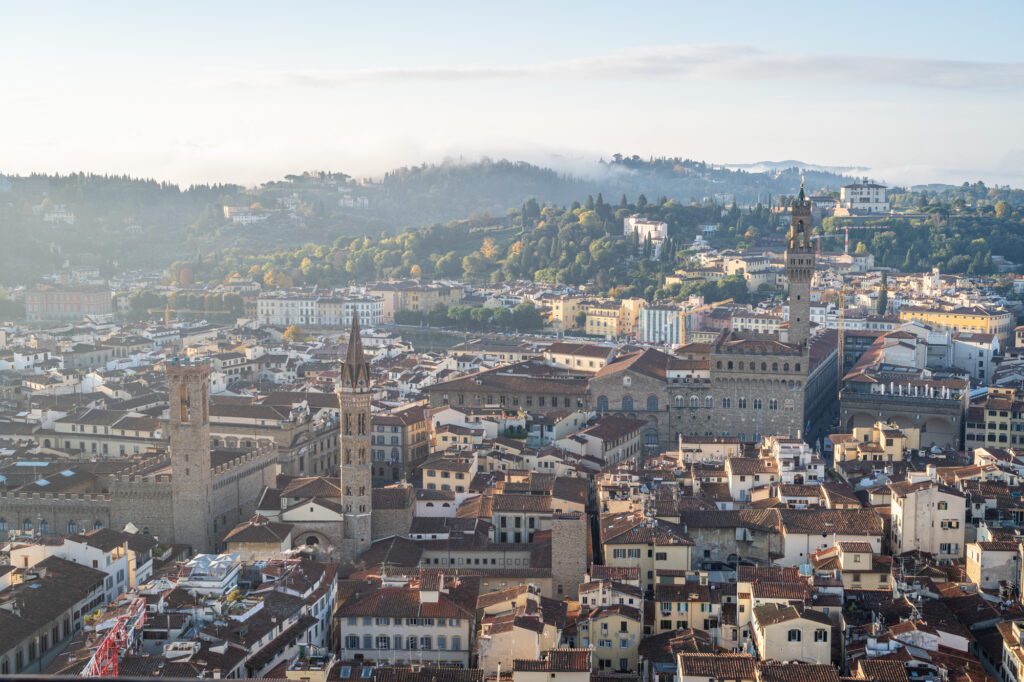
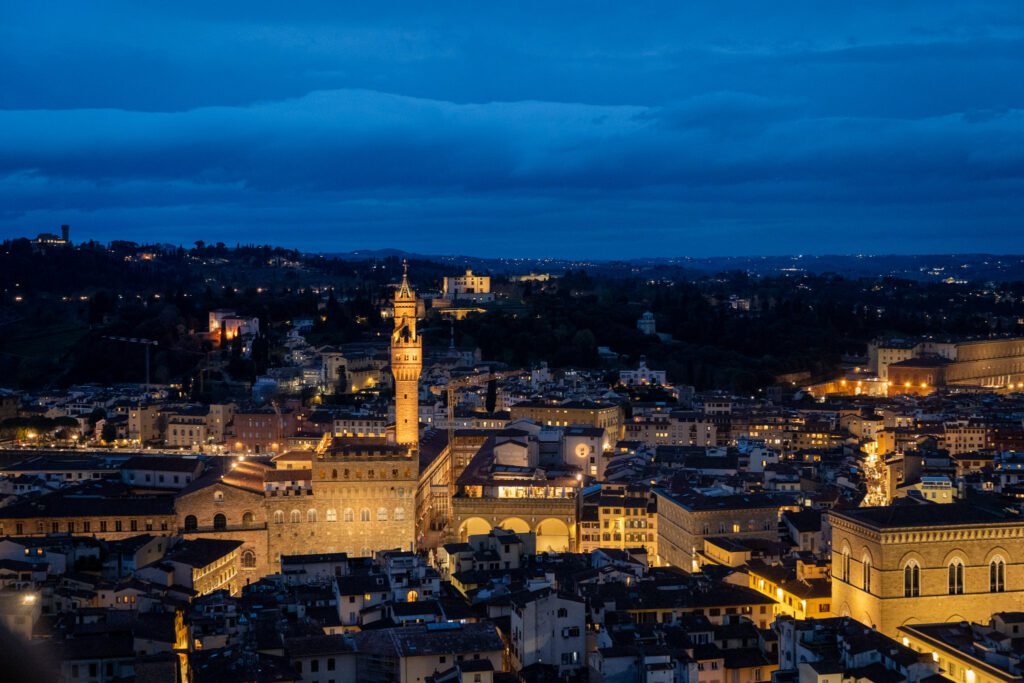
Now, it should be noted here that this climb involves 463 steps (there is no elevator) and some very narrow passageways, so it’s not for people who are either afraid of heights or claustrophobic.
There’s a point where you are shuffling along a narrow balcony (behind a glass wall, of course, it’s not like you’re at risk of falling) around the base of the dome high above the floor of the church below, which is spectacular.
However, by stopping to admire, and everybody else doing the same, you will be standing there, suspended several hundred feet up on a narrow ledge, which isn’t for everyone.
I’m not usually claustrophobic, but even I was starting to feel a little uncomfortable standing there.
We’ve now done this first thing in the morning and at sunset, and would strongly recommend that you do the early morning climb for the best light over Florence and fewer crowds.
Which means you’ll want to buy tickets for the 8:15am time slot and be in line by 8am.
It’s an early morning, but we think it’s worth it. More on how to get tickets in a section below around logistics.
The Baptistery
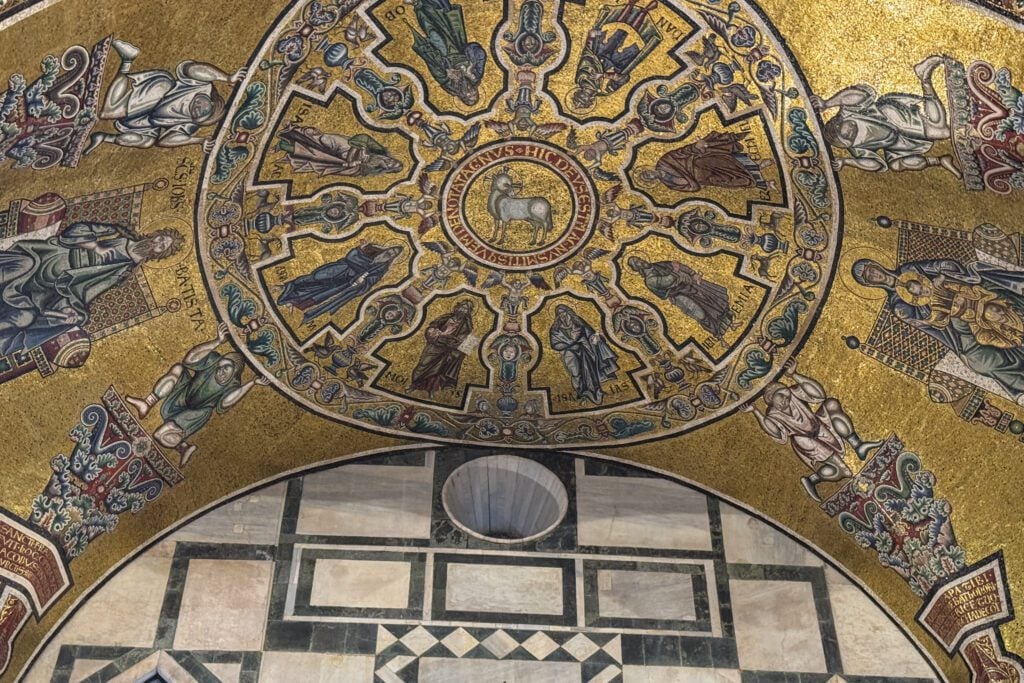
Our second favorite aspect of the complex is clearly the Baptistery and its ornate mosaics covering the ceiling. This is actually the oldest piece of the complex – it was built before the church, which is unique.
However, you should know (because I didn’t going into my latest trip) that they are currently restoring the mosaics, so they are covered by scaffolding and, therefore, not visible.
The work is going to take years, so it might be worth poking your head inside to check it out, but it shouldn’t take you more than 10 minutes because there’s just not that much to see right now.
We WOULD NOT wait in a long line to get into the Baptistery, at the moment (try going at off-peak hours on a weekday).
It’s also worth taking a look at the doors of the baptistery (located on the side that face the cathedral), which are gorgeous.
Though they are actually a replica – the originals are in the Duomo Museum, which is worth poking your head into (more on that in a second).
The Opera del Duomo Museum
This is the next aspect we’d add if you’re interested in art and architecture, and it’s relatively compact so it shouldn’t take you more than an hour or two.
You can see the original doors of the Baptistery and many of the pieces of art that USED to be inside the cathedral (and no longer are, which is part of the reason why we’d skip the interior).
The highlight here is the ornate gold door made by Ghiberti called The Gate of Paradise – it’s truly spectacular.
Tons of other marble statues, works by famous artists who worked in Florence (like Giotto and Donatello), and more.
Logistics for Visiting the Duomo di Firenze
Unfortunately, climbing the dome does mean that you have to buy a ticket that includes access to every single aspect of the complex.
However, as we covered already, we’d be strategic about your time and focus on the three aspects of the complex (the dome climb, the baptistery, the Opera del Duomo Museum).
They have three ticket options – Bruneleschi, Giotto, Ghiberti (named after artists that worked on the cathedral) – that include slightly different pieces of the complex.
The high level summary is this: If you want to climb the dome, you’ll need the Bruneleschi pass because that’s the only one that includes the dome climb (it’s also the most expensive).
If you read our descriptions above and decided the dome climb isn’t for you, the Giotto Pass includes the bell tower, Baptistery, and museum, and would be a good option.
The Ghiberti Pass includes the baptistery and museum.
It’s worth noting two things here.
First, you’ll need to book a specific time slot for the dome climb, while all of the other aspects are on a first-come, first-served basis (for those who have tickets), and you can visit them anytime over the three days following the date you select for the dome climb (this is also why we’ve put it on your first day).
Second, the dome climb is very popular and will sell out, so make sure to book well in advance.
The website to buy tickets for the Dome is here. You’ll follow that link, click on the ticket then choose a date and time slot and go from there.
If the dome climb is sold out for your dates, another option is to book a ticket through a reseller, which will be slightly more expensive but might have additional availability (because they book out big blocks of tickets to resell).
You can book those tickets here, which are exactly the same thing – tickets for entry to the Dome and the rest of the complex – but with more availability (usually).
An Introduction to Florence with Andrea
I have now done Andrea’s tour of Florence twice over the span of a few years, and on the second trip I had my mom and uncle in tow and wanted them to experience the rich storytelling that helped me fall in love with Florence’s history, which is worthy of an HBO drama.
Due to timing and logistics, we did it on our last day in Florence, and by that point I had been explaining Florence’s history for a few days.
As soon as the tour with Andrea ended, my mom pointed out that many of the facts and anecdotes I had internalized clearly came from Andrea’s tour, which we had done on our first day in Florence several years earlier.
A walking tour is our favorite way to get to know a new city when we first arrive. And it’s how we’d recommend spending the first morning of this itinerary after climbing the dome.
Not only will you be able to get to grips with the layout of the city and where to find all of the main attractions, but you’ll also learn about Florence’s fascinating past and have a chance to ask a knowledgeable local guide any questions you might have.
There are a few different walking tours of Florence that we’d suggest as an introduction to the city, but we have a specific recommendation based on our own personal experience in Florence.
We did Andrea’s Walking Tour on our first evening in Florence several years ago, and we thought it was one of the best walking tours we did during our three month adventure to Italy, Spain, and Portugal!
Then, when I returned to Florence with my mom and uncle this spring, who were new to Florence, we did it a second time several years after the first and it was STILL amazing.
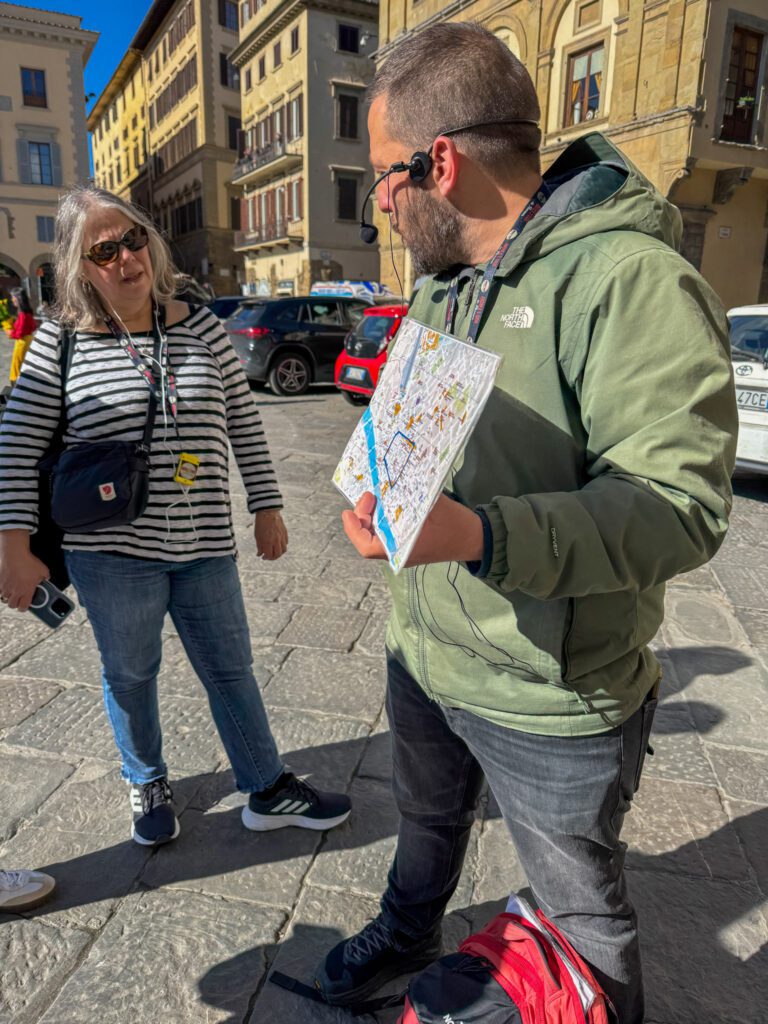
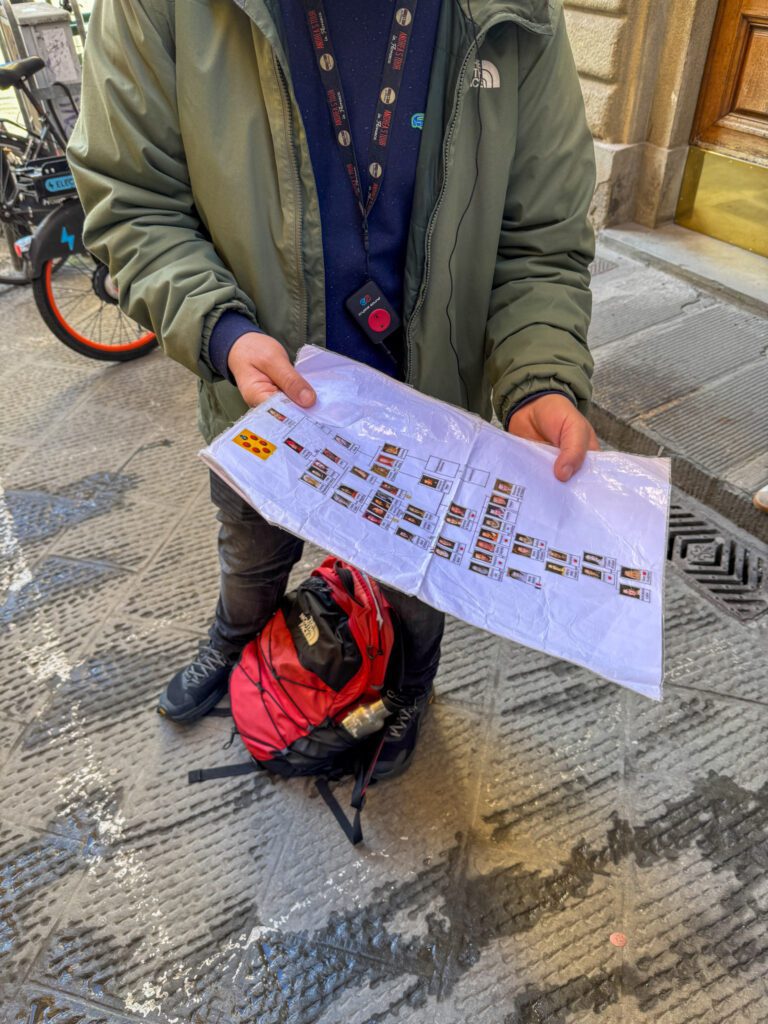
Andrea is about as Italian as it gets, and we loved the energy and enthusiasm he brought.
His tour is a great overview of the city, and we liked that it was only two hours long, so it’s plenty of time to dive into the history, see some sights, and give you enough knowledge to know what to focus your time on or come back to later, but not so long that it feels like a slog by the end.
You’ll start from Piazza di Santa Croce on the eastern side of the city and make your way to Piazza di San Lorenzo over the course of the tour, with stops at Piazza della Signoria to learn about Cosimo I de’ Medici, and see the bronze statue of Perseus, which has stood in the same spot for more than 500 years.
We highly recommend it as an introduction to Florence, and you should do it as early in your trip as you can.
Ponte Vecchio and the Arno River
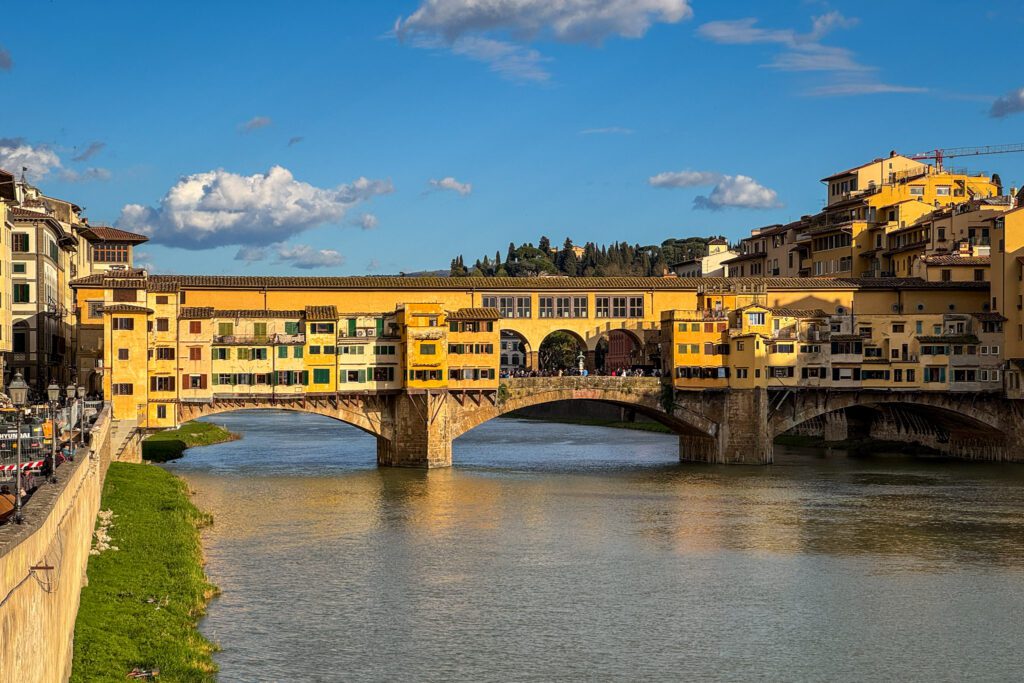
Ponte Vecchio (which literally means “old bridge”) is both the most famous and the oldest bridge in Florence, built in the 14th Century and standing in its current location ever since.
It’s the only bridge that survived World War 2 after the German retreat led to most of the bridges crossing the Arno being destroyed in an attempt to slow down the Allies (though they did barricade each end of the bridge by turning the buildings there into rubble).
The Vasari Corridor – the elevated covered walkway that connects Palazzo Vecchio (and the Uffizi Gallery) with Pitti Palace that was constructed by the Medici – passes over the top of Ponte Vecchio.
At one point, the shops on the bridge were all butchers, and they would simply toss the used carcasses over the side and into the river.
As you might imagine, the smell on the bridge was…pungent. The Medici ordered the butchers to be swapped with jewelers, a profession with sights and sounds (and smells) more worthy of their status.
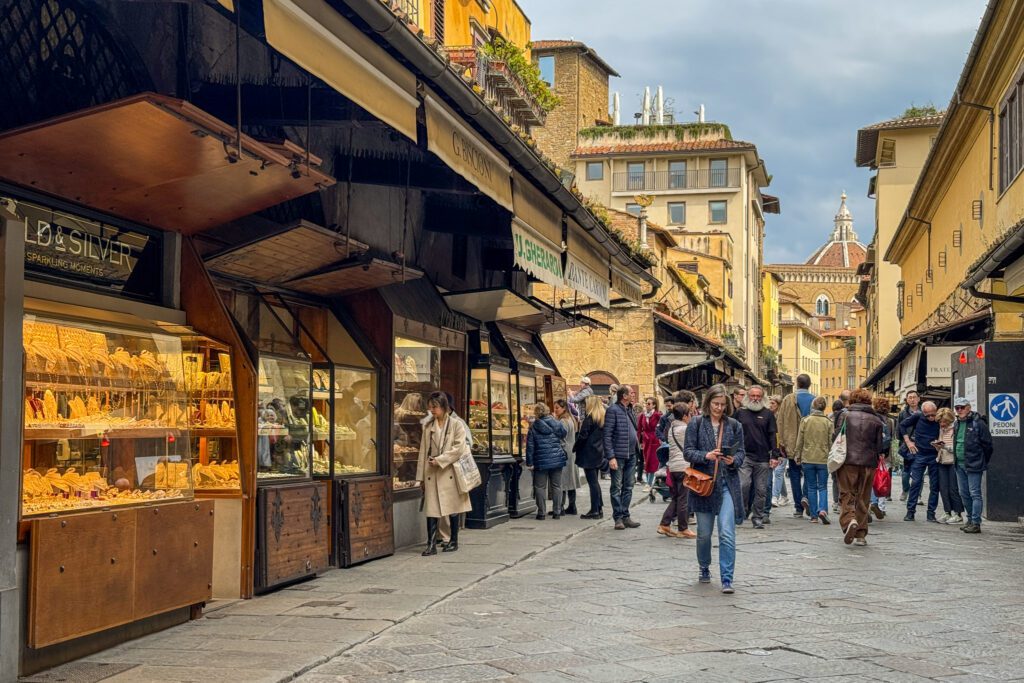
For what it’s worth, we’ve heard from multiple people (including guides) that it’s not really worth adding the cost to your visit to the Uffizi Gallery, because it’s not particularly special or interesting.
Today, you’ll find all sorts of luxury jewelry shops here – including brands like Rolex – along with hordes of tourists, but the best views of the bridge are from just up the riverbank on either side of the river (roughly here and here on Google Maps).
Exploring Oltrarno
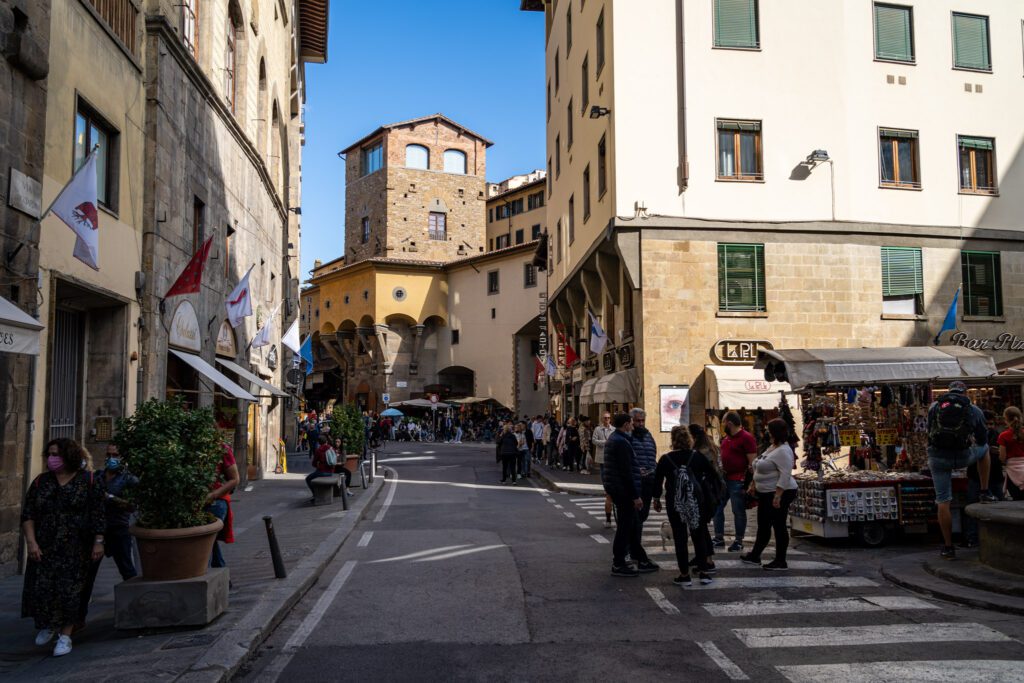
Cross the river over into the side of Florence that we prefer in terms of vibe, which is called “Oltrarno” (roughly translating to “other side of the Arno”).
Oltrarno is similar to the neighborhoods we’ve fallen in love with around the world – Gràcia in Barcelona, Trastevere in Rome, the Plateau in Montreal – in that, despite being in a city that sees a lot of tourists, the neighborhood feels like people actually live there, and the businesses that exist reflect that balance between visitors and residents.
That’s not to say that the crowds of visitors evaporate as soon as you hit the south bank of the Arno, but especially as you move deeper into the neighborhood, their presence gets less overt, and you start to hear more Italian being spoken.
- Piazza Santo Spirito is the main square in Oltrarno and is filled with plenty of shops, restaurants, and bars. Being the primary hub of activity in the area, you’ll often find markets and special events taking place in the piazza too. The basilica on the square (the Basilica di Santo Spirito) is free to enter, and is worth stepping into because it has some nice art, and is a contrast to the other, more ornate churches you’ll see in Florence.
- Pitti Palace is a series of museums and galleries housed inside a grand 15th Century Renaissance palace (the newer counterpart to Palazzo Vecchio – the Vasari Corridor was built to connect the two). Exploring the numerous fascinating galleries is a great way to spend a rainy day in Florence, but we’ve never actually done it because we’re not super into wandering through palaces (once you’ve seen one, you’ve seen around 80% of them).
- Boboli Gardens are vast and elegant gardens filled with fountains, pergolas, grottos, and hundreds of ornate Renaissance statues. If you’re a garden person like us AND it’s sometime between April and October, it’s worth visiting for an hour or two for the plants and fountains.
- Ditta Artigianale: Matt’s favorite coffee spot on this side of the river, this is their flagship cafe. They have the most “American” coffee menu I’ve ever seen in Italy, complete with specialty lattes with housemade syrups (which you just don’t see that often). Remember that you’ll pay extra to sit at a table versus getting it to go (or standing at the bar).
- Gelateria della Passera: An extremely popular gelato spot on a back alley in Oltrarno where you’ll often find a long line stretching into the square just outside its front doors. Very fresh – they store it in covered stainless steel tanks, which is always a good sign – and they have fun, rotating flavors using fresh seasonal ingredients.
- Le Volpi e l’Uva: This wine bar a few steps from Ponte Vecchio is a long-standing institution in Oltrarno, and has been here for thirty years (and won tons of awards over that timeframe). They have wines from all over Italy, but they have a bunch of nice wines from Tuscany, and are happy to chat with you to find something you like (and teach you something about wine in Italy while they’re at it).
Here’s a map that links most of those spots with the walk up to Piazzale Michelangelo and back over the river to Santa Croce, which would make for an excellent afternoon/evening extravaganza.
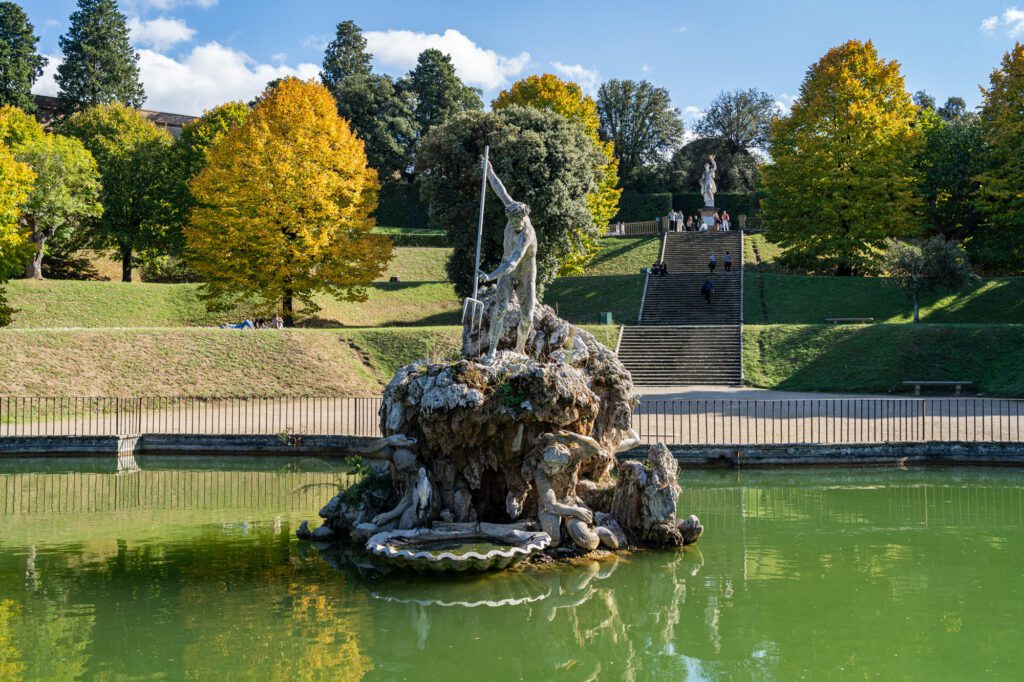
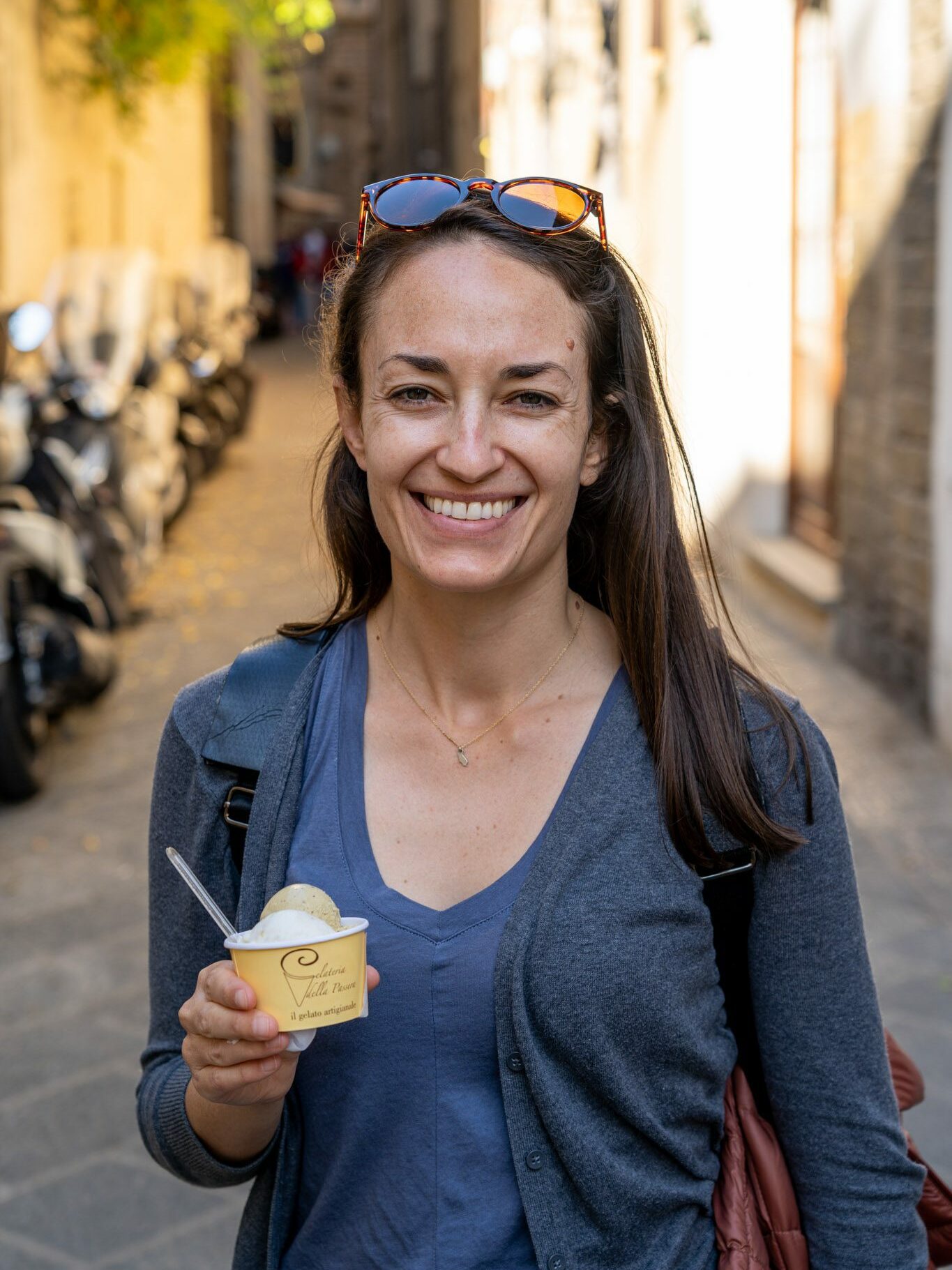
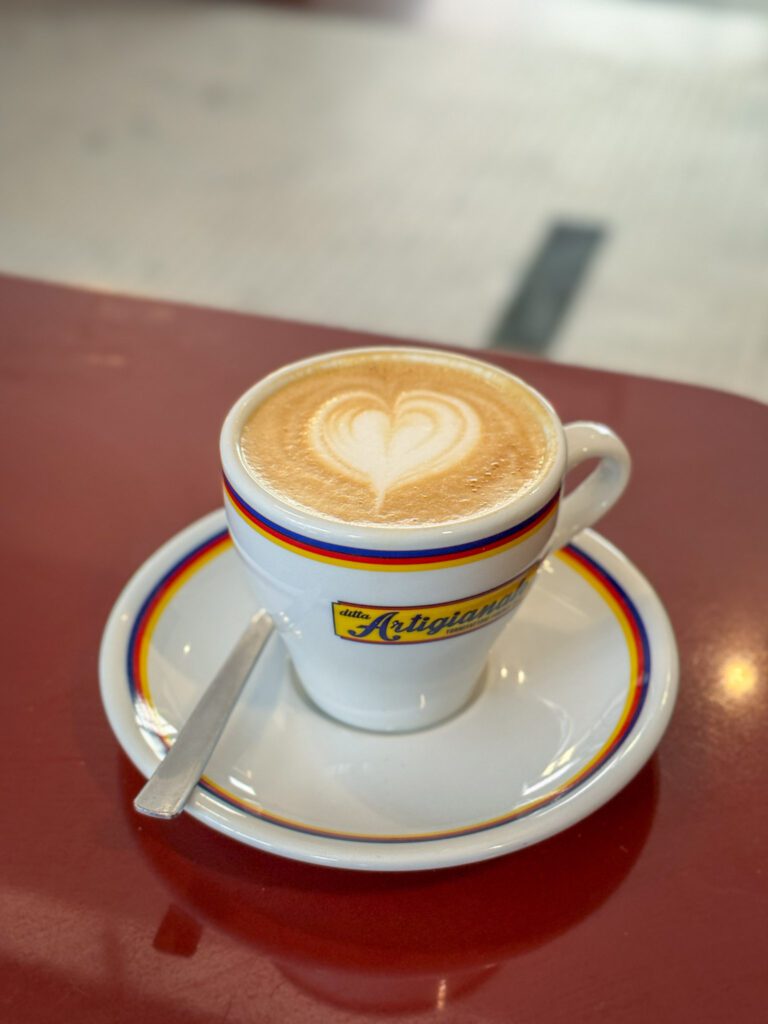
A Scenic Walk Up to Piazzale Michelangelo
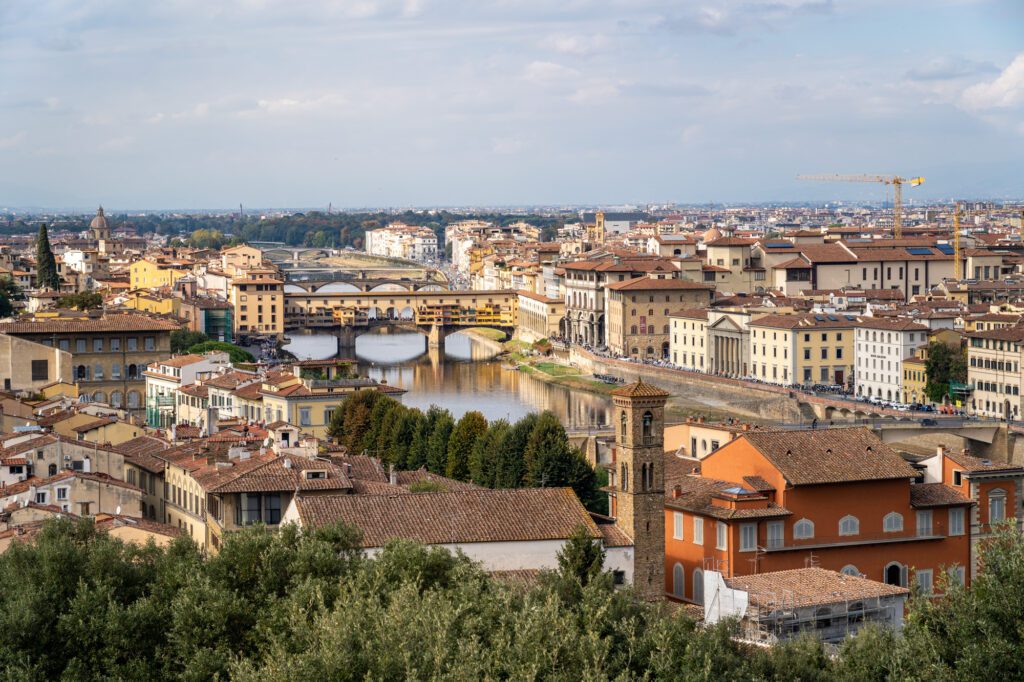
Piazzale Michelangelo sits up on a hill above the Arno river on the south bank, and is certainly not a hidden gem by any means. It’s very much on the beaten path, but that doesn’t mean it’s not worth seeing.
It’s a nice walk up from the area around Piazza Santo Spirito, especially if you detour through the Giardino Bardini and Giardino delle Rose to stop to smell the roses (if they’re blooming).
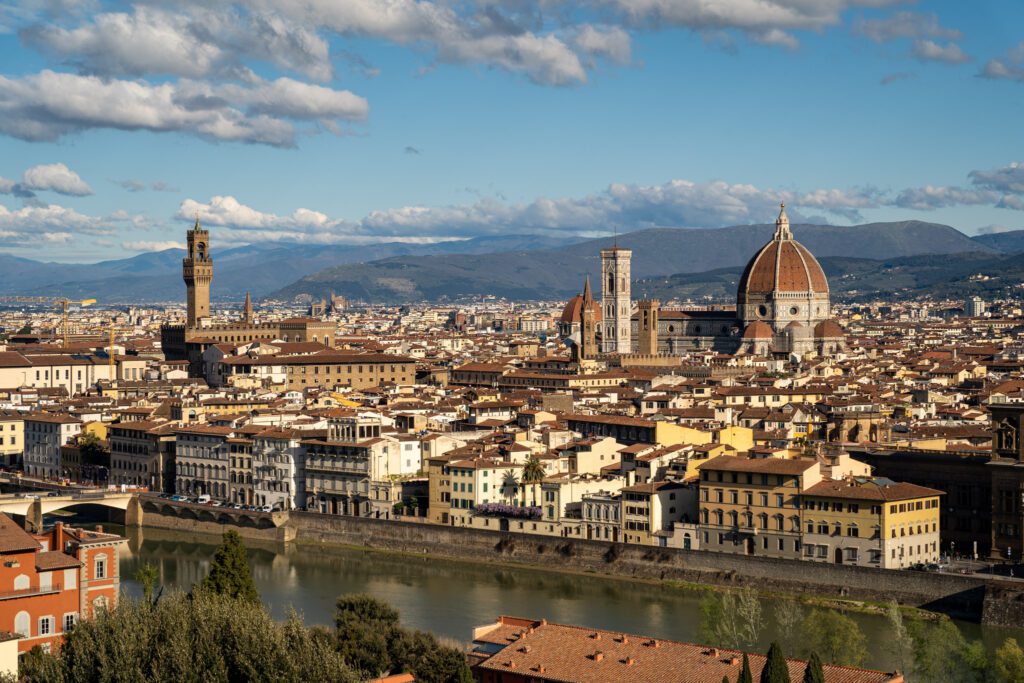
However, the vast, vast majority of people get to Piazzale Michelangelo stop there, and we actually think it’s worth going about five minutes further up the hill to both escape the crowds and get an even better view (maybe not “better”, maybe just “different”) view from the Abbazia di San Miniato al Monte, the big 11th Century church on the hill (here on Google Maps).
Depending on when exactly you’re here, it’s worth poking around at the top of the staircase leading up to the facade of the church, where there are some cool views back over the cemetery with Florence in the distance.
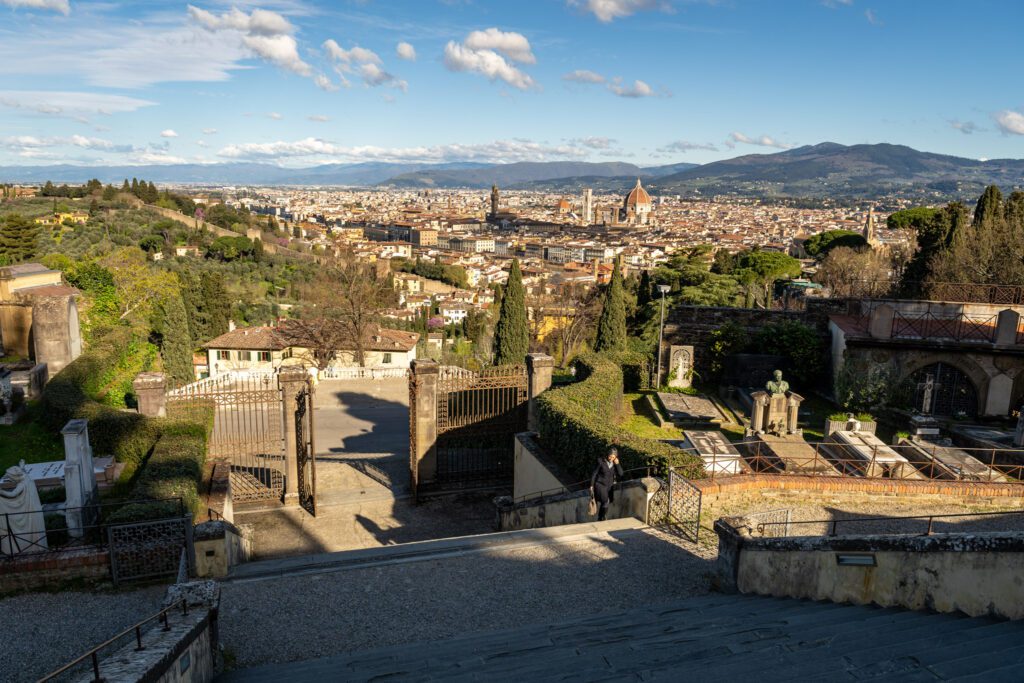
However, the gates close well before sunset for most of the year, so you might have to settle for the view from the terrace at the base of those stairs.
On your way back down, head past the Porta San Niccolò and admire the beautiful fountains and grottos built into the side of the hill.
Now, it’s important to note here that the photographer in Matt bristles at the idea of coming up here in the afternoon, because that means that, when you’re admiring the view of Florence, you’re going to be looking directly into the sun (which means less than ideal pictures).
However, there IS something romantic about sitting up on the terrace and feeling the energy as the sun sinks below the horizon and Florence bathes in that soft golden light that only comes around for a tiny fraction of the day.
Day 2: The Uffizi Gallery, Santa Croce, and a Foodie Adventure
On your second day in Florence, start with a journey through the Renaissance at the Uffizi Gallery before exploring charming Santa Croce and ending your day with a food-focused experience (either a cooking class or a food tour – your choice!).
Dive into the Art of the Renaissance at the Uffizi Gallery
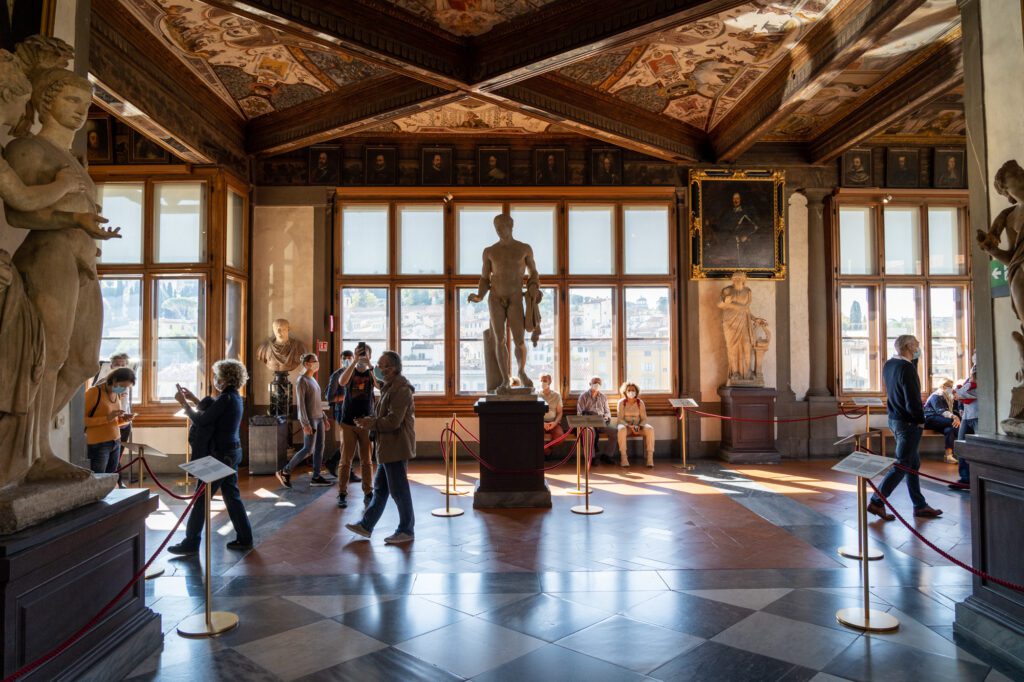
Of the two main museums in Florence, the Uffizi Gallery is BY FAR our top pick. I, Matt, have done it four different times now – twice independently, twice on a guided tour – and I still end up discovering something new each time.
On this last trip, my discovery was the collection of Rembrandt-esque pieces that use candles to light the scene and play with how the candlelight washes across the faces of the subjects.
Yes, the David is a masterpiece, and the other works in the Galleria dell’Accademia that show you how Michelangelo’s relentless pursuit of understanding the human body led to the creation of the marble masterpiece.
What we really love are art museums that tell a coherent story, either about the place they’re located (the National Portrait Gallery in London), a specific movement (the Musée d’Orsay and Impressionism), or a specific artist (the Rodin Museum in Paris).
Similar to the Musée d’Orsay in Paris, which tells a compelling story about how the bad boys of Impressionism shirked conventional wisdom and forged their own path that later became one of the most iconic movements in art history, the Uffizi Gallery tells a story about the painters of the Renaissance that is inherently intertwined with the history of Florence.
A lot of people, us included, assumed that Florence became a wealthy city because it had all of this beautiful art.
But the truth is actually the inversion of that statement – Florence was able to commission all of this gorgeous art because of its immense wealth, which was required to commission the famous artists of the Renaissance.
The Uffizi Gallery is a chronological walk through time, starting with the period immediately before the Renaissance, where you had people mostly painting Jesus in two dimensions with a golden halo around his head, to the end of the Renaissance, when people were painting life-like figures in three dimensions that looked like real humans.
The word “Renaissance,” as you might already know, means rebirth, and refers to the return to the Greek and Roman classics that had so influenced the world before Christianity took over.
As I mentioned, we have been to the Uffizi Gallery multiple times, first on our own, then with the audio guide, then on (multiple) guided tours.
It wasn’t until the first guided tour we did (here is that tour) that we truly began to grasp what exactly we were seeing; a revolution in the art world that began and flourished in Florence.
We’d strongly recommend a guided tour here, and would rank it as the most important historical/museum tour to do in Florence because the story of the Renaissance really requires a bit of extra explanation and context.
Of the tours I’ve done, this tour was by far the best crash course, and it ends inside the museum so you can spend more time, if you’d like.
If you’re not going to do a guided tour, you’re going to want to book your tickets for the Uffizi Gallery well in advance, and plan the rest of your time in Florence around that time slot.
This is the official website of the museum, and similar to the Vatican Museums, you’ll want to either book the first few time slots of the day (what we did on our past trip to Florence) or a later afternoon time slot, when the museum tends to be a little bit quieter.
Exploring Santa Croce + Sant’Ambrogio
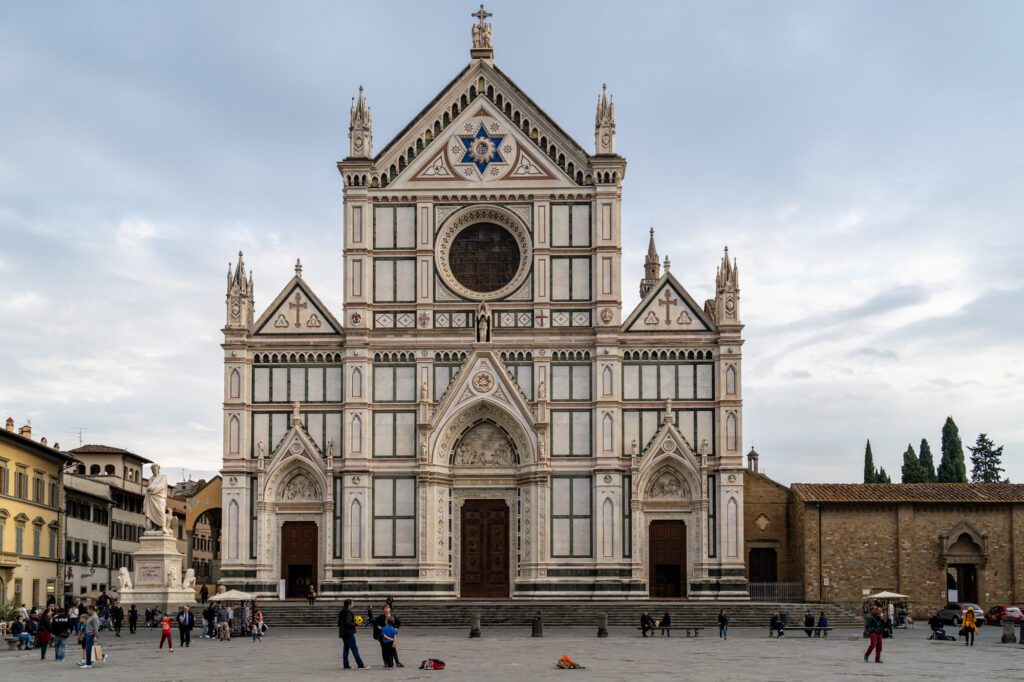
Santa Croce and Sant’Ambrogio are the pair of neighborhoods immediately to the east of the historic center, a 10-15 minute walk from places like Piazza del Duomo and Piazza della Signoria.
The neighborhood’s two major landmarks are the Basilica di Santa Croce – which is the area where Michelangelo grew up (and his tomb is inside the basilica) – and the Mercato di Sant’Ambrogio, which is a covered food market that is a good option for lunch (or an afternoon snack).
Technically, Sant’Ambrogio is so-named because of the church of the same name (a theme you’ll see all over Italy), but today the Mercato is more of a landmark to us.
This part of the modern city of Florence was once outside the city walls and was a very poor part of the city, but it has since become one of the most desirable neighborhoods in all of Italy.
The Basilica di Santa Croce is a Franciscan church, which is an order dedicated to serving the poor (it’s actually the biggest Franciscan church in the world).
Aside from Santa Croce and other attractions, it also happens to be a great place to eat and drink. Here are some spots we think you shouldn’t miss.
- The Basilica di Santa Croce: Our favorite church interior in Florence, at least partially because many of the city’s famous scientists and artists (like Michelangelo, Galileo, and Machiavelli) are buried here and have ornate tombs inside. Plus, tons of amazing art on display, and a nice cloister. Buy your ticket online in advance to skip the long line at the ticket office and head straight to the security line.
- The Scuola del Cuoio: While the open air leather market near Mercato Centrale might seem like a fun experience, the reality is that the leather being sold there isn’t exactly the highest quality. It’s fun to look at all of the goods on display, but if you want the true Italian craftsmanship that made Florence rich, you should head over to the leather school, which also has a shop where you can purchase belts, bags, wallets, and just about anything else you can imagine. I got Alysha a nice green leather coin pouch here, and they monogram it for you when you buy it, which was fun.
- Mercato di Sant’Ambrogio: Of the two main food markets in Florence (the other being Mercato Centrale), this one feels significantly more down to earth and real. Lots of vendors to explore, some of which sell ready-to-eat foods, some are selling specific ingredients like cheese, meat, or veggies. The market is at its busiest (and most exciting, we’d argue) in the early morning, when the outside area is taken up by a fruit and vegetable market, but another good time to come is for a late lunch, when you can eat your way from stall to stall gorging yourself on things like trippa alla Fiorentina (delicious) and lampredotto (more tripe!), among other traditional Fiorentine delicacies.
- Enoteca Alla Sosta Dei Papi: A tiny little wine bar along bustling Via Pietrapiana that we stumbled upon a few years ago, and return to every time we’re in Florence.
- Coffee Mantra: My favorite coffee shop in Florence, they use coffee from a local roaster (Gearbox) and rotate the single origin they have available on a weekly basis.
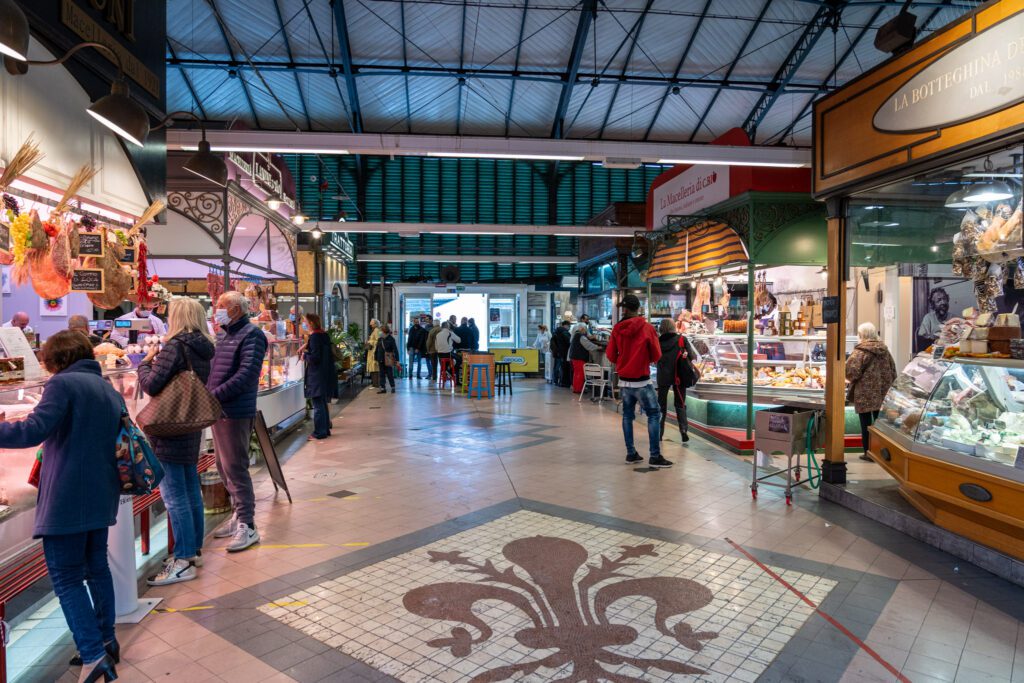
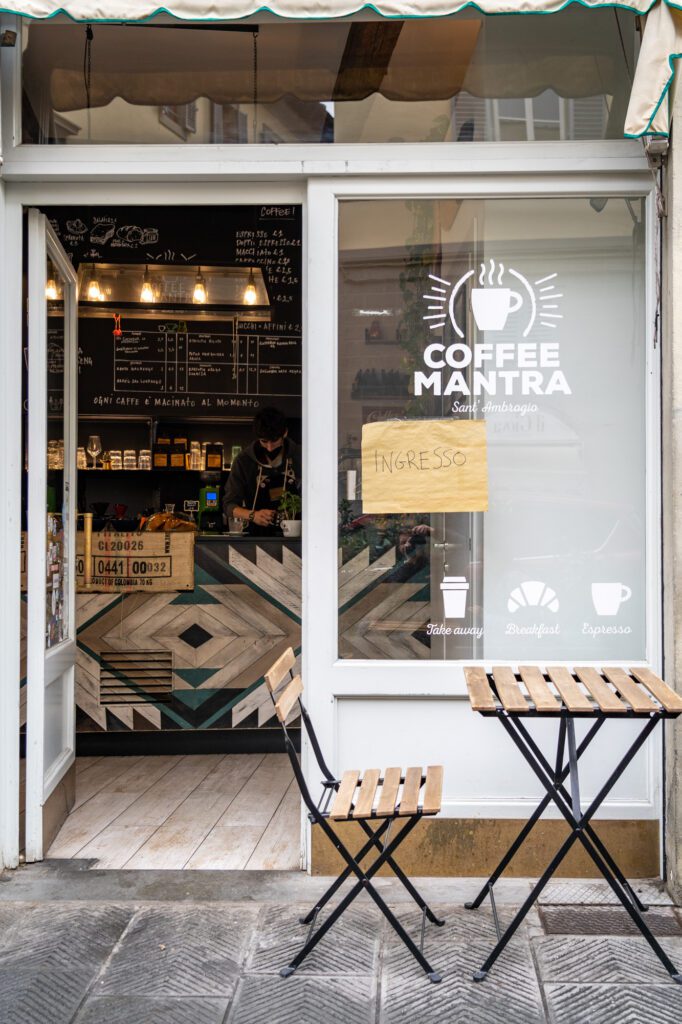
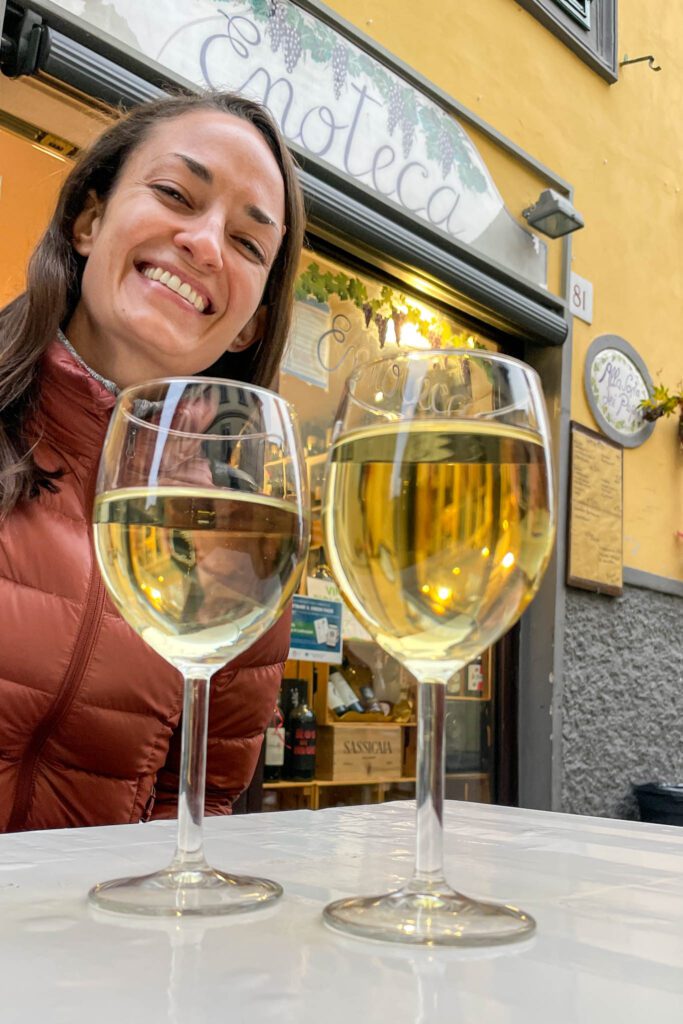
Choose Your Own Foodie Experience
Diving into the food culture in places we’re visiting is one of our favorite aspects of traveling, and we try to include a food tour, cooking class, or market tour in most places we visit.
Unfortunately, the reality is that because Matt has Celiac Disease and can’t have even a speck of gluten without being sick for days, a food tour or cooking class usually isn’t in the cards for us.
HOWEVER. That does NOT mean it shouldn’t be for you! We’d highly recommend it because it gives you a local’s perspective on the city’s food scene – what and where to eat and drink – and you get to connect with fellow travelers and try some amazing food.
In Florence, we actually found a completely gluten free cooking class (this one) that I did on my latest trip, which was an excellent way to learn about Italian food culture, meet some like-minded travelers, and eat some delicious food (with the recipes to make it at home, too!).
Here are some options for you, split between food tours and cooking classes. Our bias is to do a cooking class, because we LOVE to cook, but we also enjoy a good food tour.
Option 1: Learn to Cook Italian Food with a Cooking Class
We’ve done all sorts of cooking classes around the world (read about our cooking class in Mexico City here), and while the gluten-filled nature of Italian food makes it nearly impossible to find a safe cooking class.
However, there happen to be multiple gluten free cooking classes available in Florence, which means Matt got to make fresh pasta for the first time in his life!
Fear not, if you’re not gluten free, the cooking school we went to has gluten-full options (which we’ll link below).
If you’re gluten free, we highly recommend the gluten free cooking class I did with my family, which was one of the highlights of that particular trip to Italy.
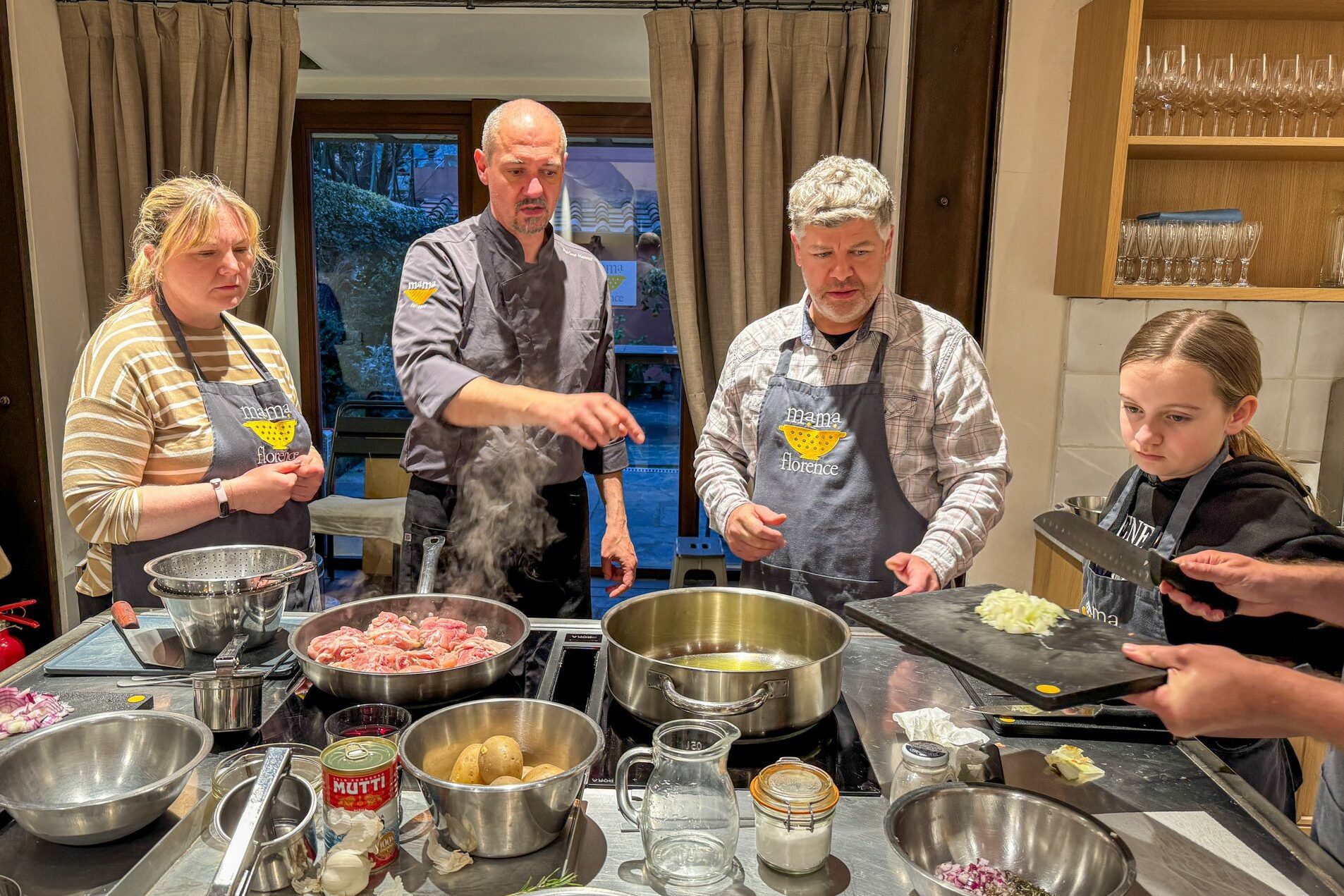
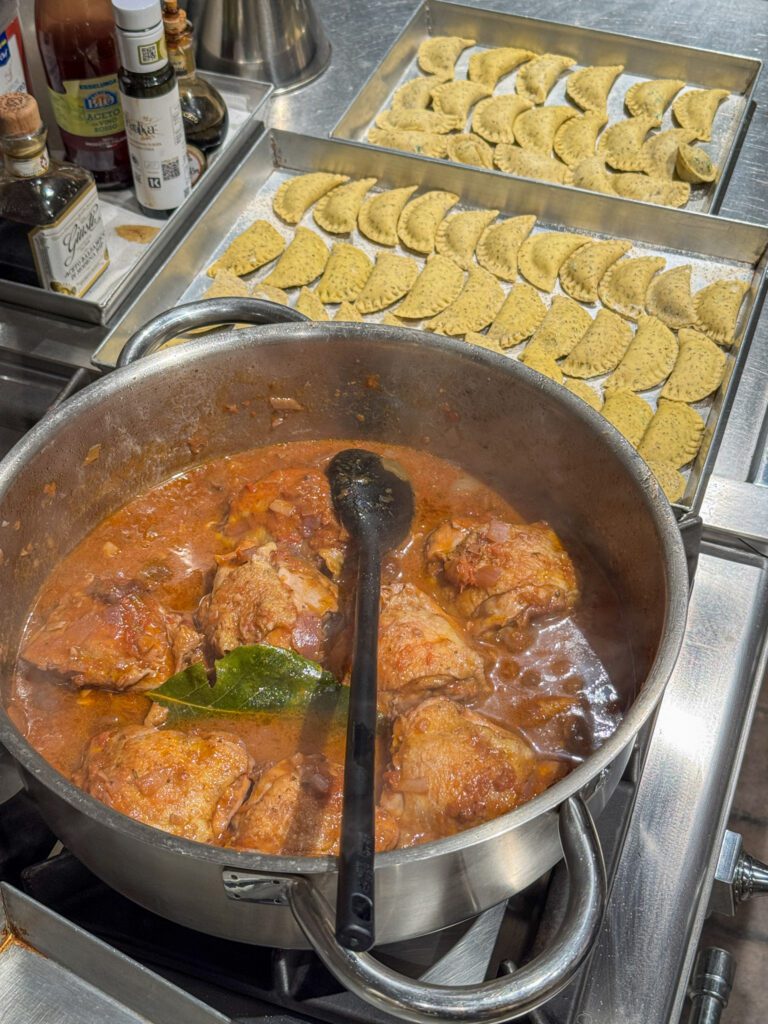
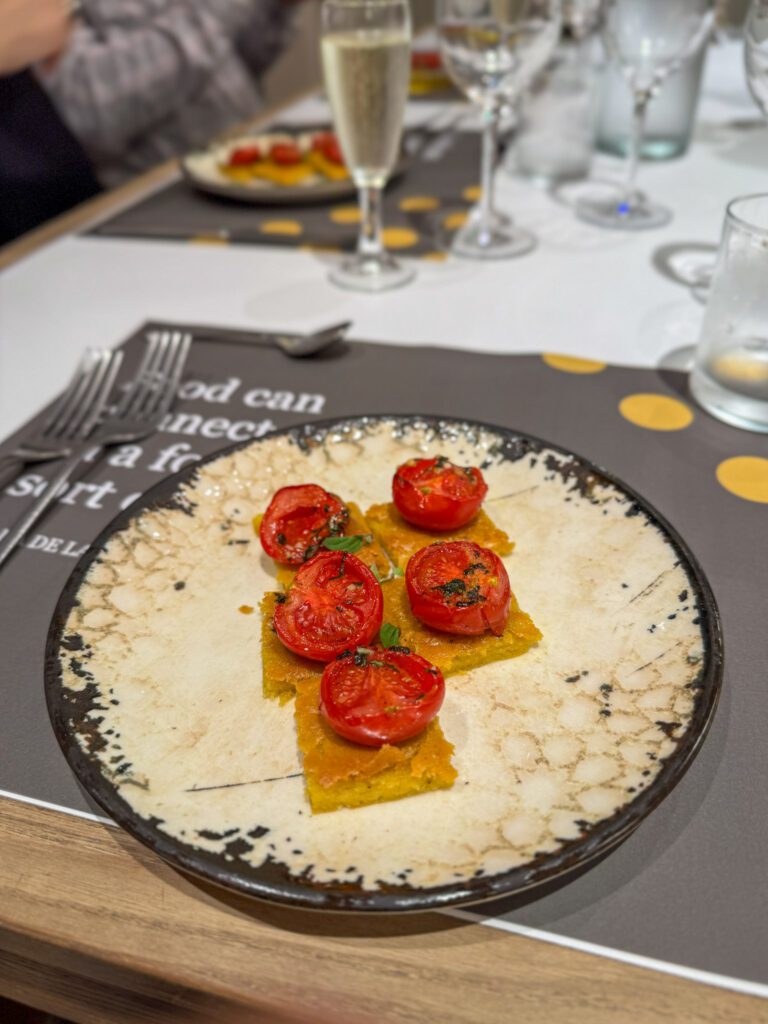
We still make the chicken cacciatore at home (they send you the recipes after class).
Surprisingly, there are actually two gluten free cooking class options in Florence – the other one being this three hour class, which we’d also consider.
If you’re not gluten free, here are the two options we’d look at – one in Florence itself (that includes a market tour), and one outside of Florence in the Tuscan countryside (which is a nice change of pace).
- Market Tour and Tuscan Cooking Class in Florence: This class is with the same company we used, but is the version that uses gluten AND does a market tour as part of the class (which we always love to do because you get so much more out of it than if you just walk through the market on your own). It’s at their beautiful cooking studio in Oltrarno, just a short walk from the center of Florence. You’ll make a three or four course meal, enjoy some local wine, and get the recipes sent to you at the end of the night to recreate the magic at home. There’s also a shorter version that skips the market tour, if that’s not something you’re interested in.
- Pasta Class in the Tuscan Countryside: We like this class because it takes you outside of Florence to an estate in the countryside, which lets you see a different side of Tuscany (plus, it includes the transportation!). It’s a lunchtime class, which means you get a relatively early start in the morning, which might change some other plans on the day you do it. You’ll make multiple kinds of pasta (usually a filled pasta like tortelloni and a fresh pasta like tagliatele) and a dessert, and, of course, drink plenty of wine. It’s a longer experience, and might make more sense as a day trip you do, depending on what you’re interested in.
Option 2: Take a Food Tour to Dive Deeper into Florence’s Food Culture
Food tours are another great way to get a level deeper, and often include many stops that take you to a variety of trattorias, gelaterias, and osterias along the way.
Here are some food tours that caught our eye though, sadly, we also skipped these because of the whole gluten and cross-contact issue.
- Oltrarno at Sunset (Food & Wine Tour): This tour is with our favorite company in Italy (really, their sister company, Devour) and takes you on a journey through Florence’s food culture over the course of three-ish hours in the evening, focusing on the other side of the river, Oltrarno.
- Florence Sunset Food & Wine Tour: This tour is with a company that my mom has done multiple tours with around Europe (Lisbon and Milan) and loves, though for gluten reasons, I’ve never experienced their tours. This is also focused on Oltrarno, which is our favorite part of the city to explore because it feels like real people actually live there (unlike the historic center).
Day 3: Choose Your Own Day Trip Adventure
As we’ve already mentioned multiple times in this guide, one of our favorite parts about Florence is the fact that it’s an excellent home base for day trips to other parts of Tuscany and beyond.
For your third day, we recommend taking advantage of Florence’s strategic location to get out of the city and see a different side of Italy.
We have an entire guide to our favorite day trips from Florence, which has both more options and more information on each option, but we’re going to give you our three favorites and let you choose based on your own interests.
Those three options are Bologna, Siena, and Chianti. Each offers a different reason for visiting (which we’ll cover below).
Now, we’ve gotten several questions here about seeing multiple places in one day because they aren’t really that far apart. That’s not really our style (mostly because we have the gift of time and would rather spend more time in fewer places), but we completely understand the impulse.
If you’re up for a long day, we’d look at this tour with Walks of Italy which covers Siena, a long lunch at a farm in Chianti, and San Gimignano.
We love Walks of Italy (we’ve done many tours with them at this point – seven at the time of writing), and though we’ve never done that particular tour, the itinerary looks great to us.
Option 1: Bologna (for Foodies)
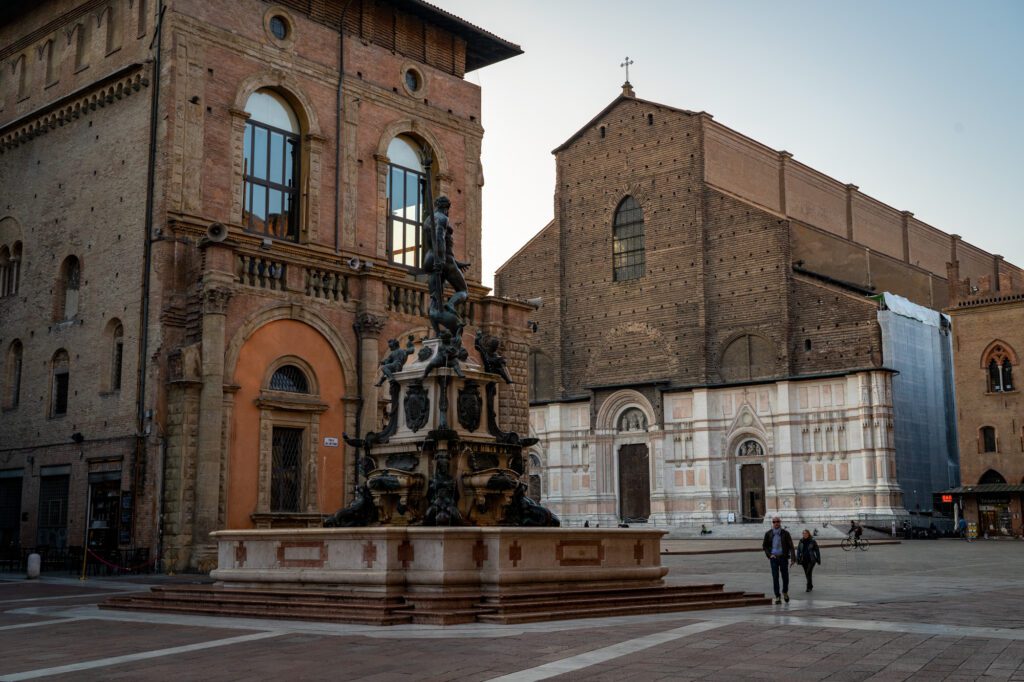
Bologna is our favorite city in Italy, full stop. We’ve been multiple times, and there are a couple of reasons why we think Bologna should be a piece of your Italy itinerary.
First, the food. Bologna is, without a doubt in our minds, the best food city in Italy.
It’s the capital of Italy’s Emilia-Romagna region, which is the region that is known for Italian delicacies like tagliatelle al ragu (which is similar to the American version Bolognese, but is very different than what I think you’re probably picturing, at least if you’re American), parmigiano reggiano, prosciutto di Parma, balsamic vinegar from Modena, and mortadella.
Plus, all the filled pasta – tortellini, tortelloni, and more.
Basically, if you want to experience some of the best food Italy has to offer, a day trip to Bologna should probably be on your agenda.
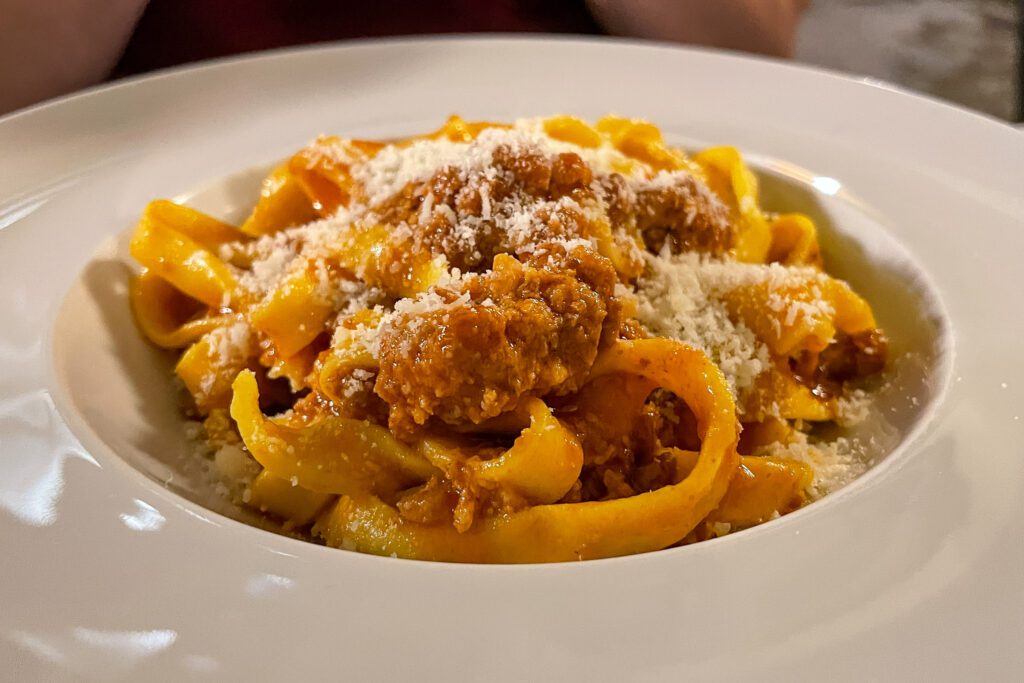
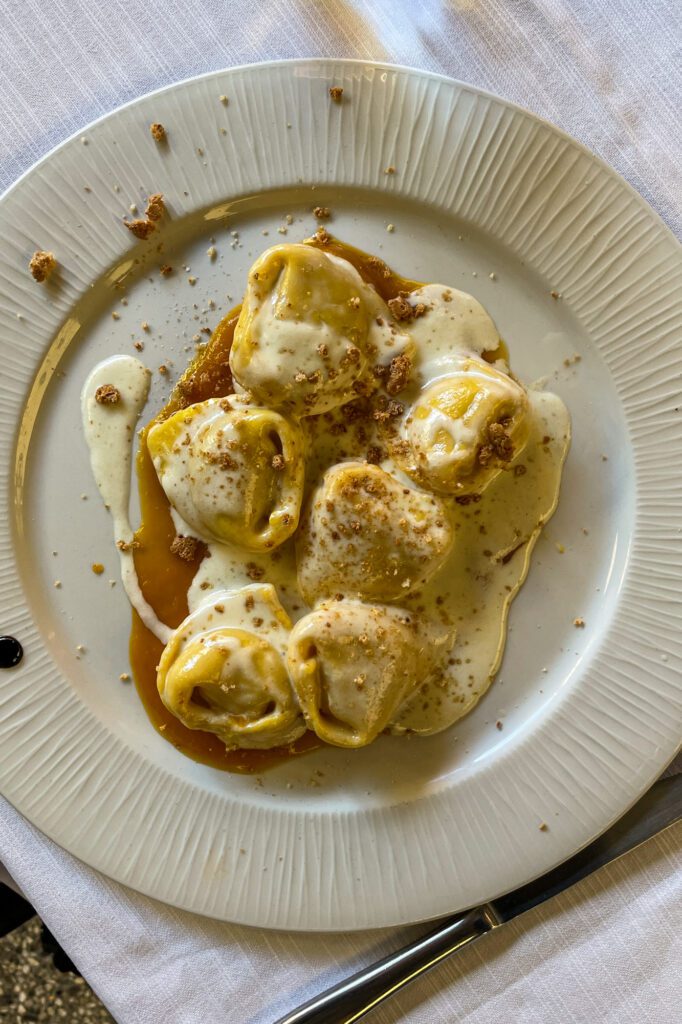
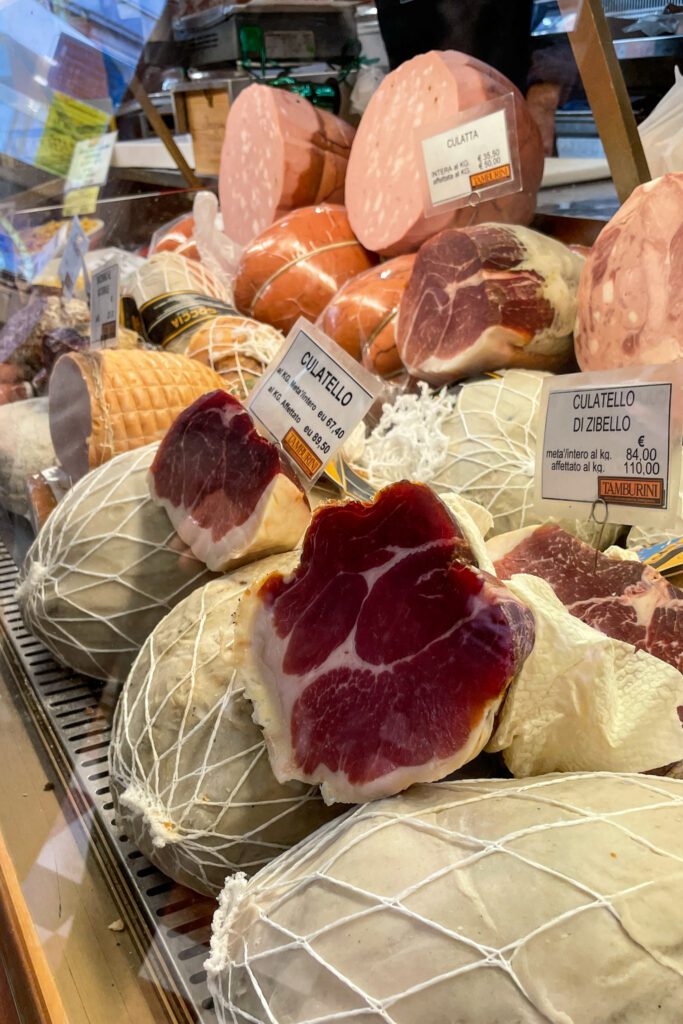
Second, the atmosphere. Bologna is, at its core, a university city, and is home to one of the oldest universities in the world. That means a big student population (especially as a percentage of the total population), which we think gives Bologna a unique vibe among Italy’s bigger cities.
Third is the fact that getting to Bologna from Florence is about as easy as it gets, with a high speed train connecting the two cities in 45 minutes.
We have an entire guide dedicated to planning a day in Bologna, which you should read for more information on what we’d do with limited time.
Option 2: Siena (for a Different Side of Tuscany)
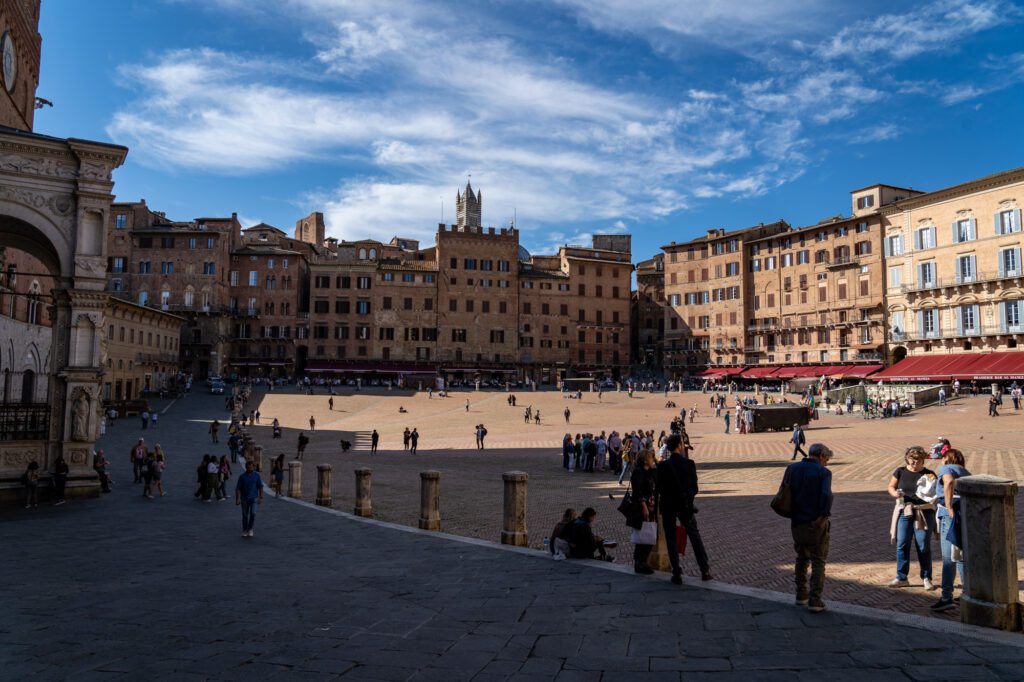
If you’ve ever read about Tuscany before, you might know that Tuscany was once a series of city-states that were all competing for resources and power in central Italy.
Many of these cities were strategically located atop a hill and encircled by walls to protect them from other groups.
Siena is perhaps the best example of a Tuscan hilltop town, with its red brick roofs cascading down the hill from the city center, which sits at the top of the hill.
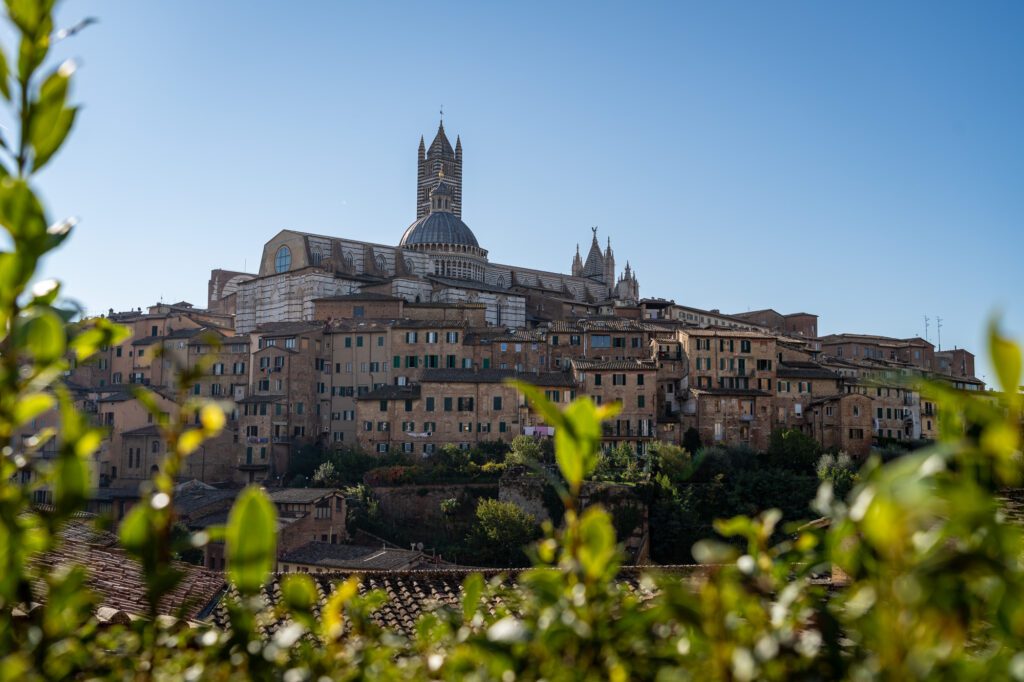
During the 13th and 14th centuries, the city of Siena rivaled nearby Florence in its wealth and power. And, because of the wealth and power accumulated here, it’s where you’ll find some of the finest art and architecture in all of Italy.
Siena is one of the most popular day trip destinations from Florence, which means that it’s incredibly busy from mid-morning through the late afternoon, so an early start will be your best friend here.
In terms of getting to Siena, you basically have two options; the regional train (booked through Trenitalia) and the bus (booked through AT).
Both take roughly an hour and a half, and leave from Santa Maria Novella (the main train station in Florence), and both arrive at the bottom of the hill that Siena sits on top of (which means some walking to get to the top).
Here are a few things to do and see in Siena that we’ve enjoyed.
- The Duomo di Siena: The Duomo di Siena is an impressive work of art, particularly the beautiful mosaics on the floor, which we were lucky enough to see on a recent trip (they’re often covered up). It’s similar to the Duomo you’ve already seen in Siena, but we’d argue that this is more opulent than that one (especially the interior). Buy tickets here.
- Take a Walking Tour: Siena is a city with a long and interesting history. And a great way to learn about it is on a guided walking tour with a local guide. We did this tour and it was an excellent introduction to Sienese history and culture. It even included a visit to the cathedral, which is a fascinating place to explore with a guide who can teach you about the architectural elements and historic artwork.
- Marvel at Piazza del Campo: Piazza del Campo is the main square of the city, and is the place where the world-famous Palio di Siena – a horse race that has been taking place in Siena for hundreds of years. The square is impressive, and it is worth stepping into the Palazzo Pubblico to learn about Siena’s governance when it was independent and marvel at the art on display.
- Eat your way through Siena: Siena’s cuisine is similar to that of Florence, with some slight twists. Definitely head to Torrefazione Fiorella (here on Google Maps) for the experience of rich espresso at a bustling bar full of people speaking Italian. One of the owners of the agriturismo I stayed at a few years ago STRONGLY recommended Du’ Cose da Berna, a sandwich shop in the center of Siena, for lunch (with La Prosciutteria as a second option). For dessert, head up to Panificio Il Magnifico for their ricciarelli, a typical Sienese cookie (among other types of biscotti and various baked goods).
Option 3: Chianti (for the Wine)
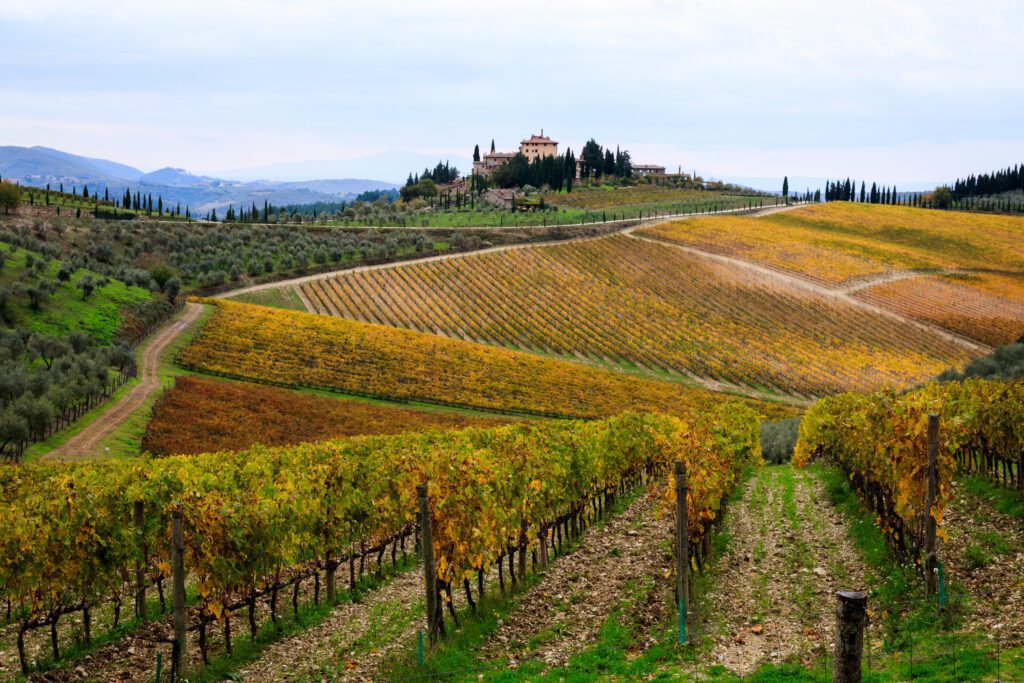
I (Matt) have now explored Chianti twice – once as part of a broader Tuscany road trip, and once as a day trip from Florence – and I would absolutely go back a third time if given the chance.
Chianti – specifically, Chianti Classico – is one of the most famous wine regions in the world, and is associated with the D.O.C.G. and the black rooster sticker on the label.
For reference, D.O.C.G. is just a classification that means a product is made in a specific place in a specific way that is regulated to guarantee the quality of the resulting product.
It’s a common way to classify wines and other food products in Italy and broader Europe (balsamic vinegar di Modena, prosecco, and champagne are all examples).
The region is easily accessed from Florence, and is only about 30-45 minutes outside of the city depending on where exactly we’re talking about.
The biggest challenge with Chianti is getting there.
While it’s close to Florence, there are really no public transportation options available, especially if you want to get outside of the small towns and to the wineries that make this part of the world special.
Which leaves you with two options: Rent a car and drive yourself, or take a guided tour from Florence that includes transportation.
There are obviously pros and cons for each approach, and we’d argue that, based on our experience, the best way to experience the wines of Chianti is on a wine tour that leaves from Florence and includes transportation so that you can both enjoy the wine tasting without worrying about driving, and not have to deal with a car in Florence.
In terms of guided tours, you have two options. You can either choose a tour that goes deep on a single winery, usually including a cellar tour and detailed tasting (but you’ll have to make your way out to the winery), or a tour that takes you around to multiple wineries.
Lucky for you, over the course of several trips to Florence and a trip to broader Tuscany, we’ve done it both ways, and have thoughts.
Generally, we think the best version of a Chianti wine tour involves multiple winery stops and a nice, leisurely lunch to break them up. As you might imagine, that also is typically a more expensive way to do things.
On every trip, there’s usually one experience that stands out in our minds as THE experience of the trip.
A few years ago, we spent some time in Portugal and did a wine tour of the Douro Valley that we still talk about as one of the best tours we’ve ever done, period (and we’ve sent multiple friends and family on the exact same tour).
At the time I booked that tour, I said “this is kind of expensive, but it seems like it’s actually a good value considering what you get.”
The reason I’m bringing up that tour in Portugal? The tour I (Matt) did with my family on my latest trip to Florence was equally good (and I had the same budget question before doing it).
If you’re looking for an excellent all day wine experience that includes transportation, multiple winery stops, and a beautiful lunch (more on lunch in a second), we can’t recommend this tour of Chianti more highly. It’s also a tiny group – a maximum of 8 people – which is almost the best part (we love small groups!).
It also includes lunch at a famous butcher – Dario Cecchini’s spot in the tiny town of Panzano – which was…an experience.
Dario is an eighth generation butcher with a handlebar mustache and a cult following, and we had NO IDEA what we were getting ourselves into.
There were trumpets playing (by Dario himself) to open the restaurant, excellent wine, and course after course of meat-focused dishes (one of which was among the best things we ate in Italy on that trip).
One note: Not a great option for vegetarians – they have another tour that focuses more on cheese that might be a better option if you don’t eat meat.
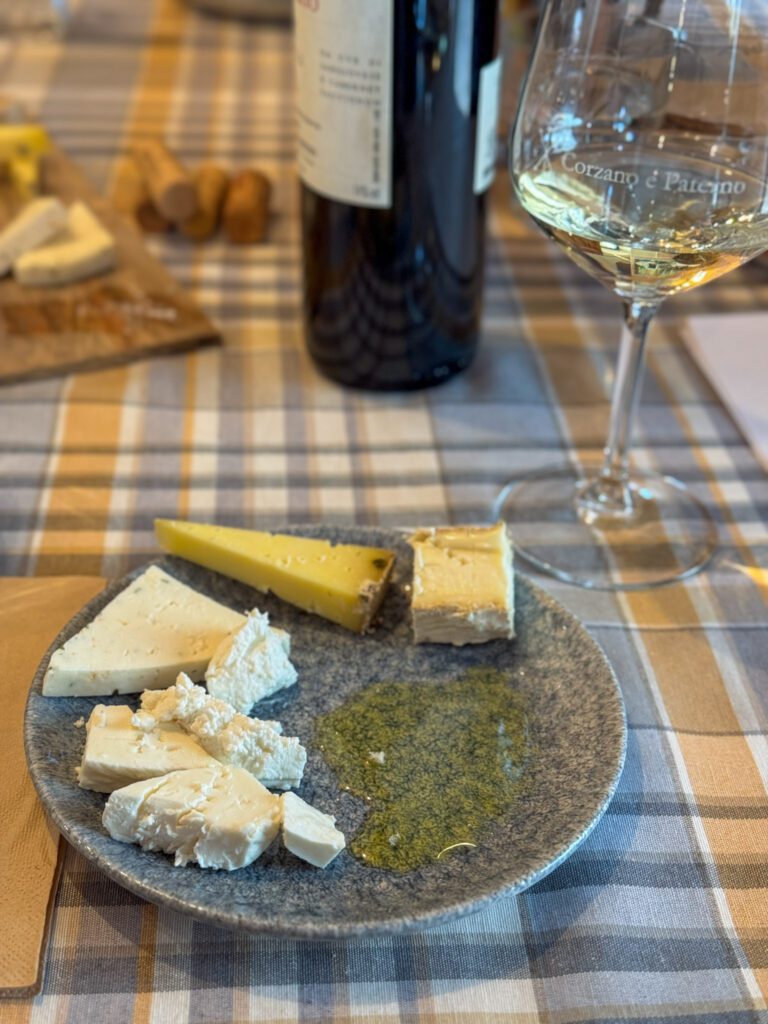
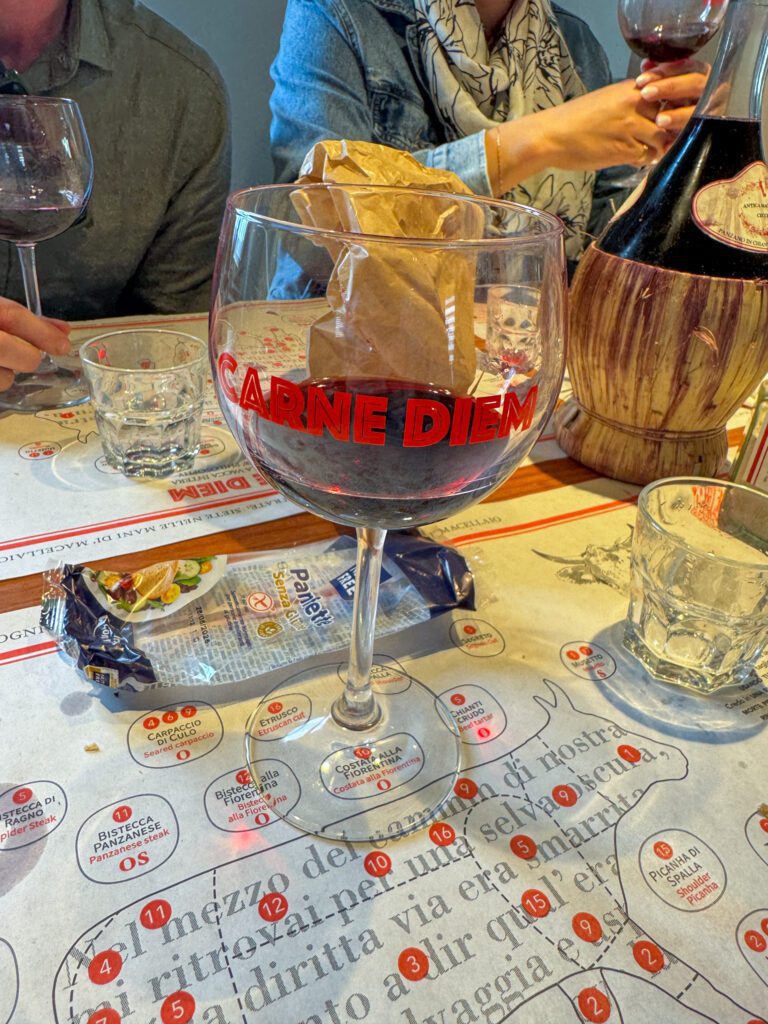
This other Chianti tour – which they call a safari because it’s done in a 4×4 vehicle – was the other option that I had on my list, but I ultimately went with the other tour for gluten free reasons (they were more than happy to accommodate me, which I appreciated, though I never asked this second company).
You could also do it independently if you have a rental car.
But, it’s going to be a much more enjoyable experience with a group tour where you have a driver so you can imbibe in all the amazing wine without worrying about getting behind the wheel, and you’ll get to meet other like-minded travelers along the way.
On a trip to Tuscany a few years ago for my mom’s 60th birthday, we also did this great winery tour, which focuses on a single, tiny winery (and requires you to get yourself there).
Pro tip: If you’re buying Chianti Classico at home or somewhere else in Italy, make sure it says “Chianti Classico” (versus just “Chianti”, which we learned can be made elsewhere in Tuscany) and has a rooster logo somewhere on the bottle, which is how you know it’s legit.
What to Do with More Time in Florence
If you find yourself with extra time in Florence, here are a few places we’d consider adding to your itinerary.
The David & the Galleria dell’Accademia (+2-3 Hours)
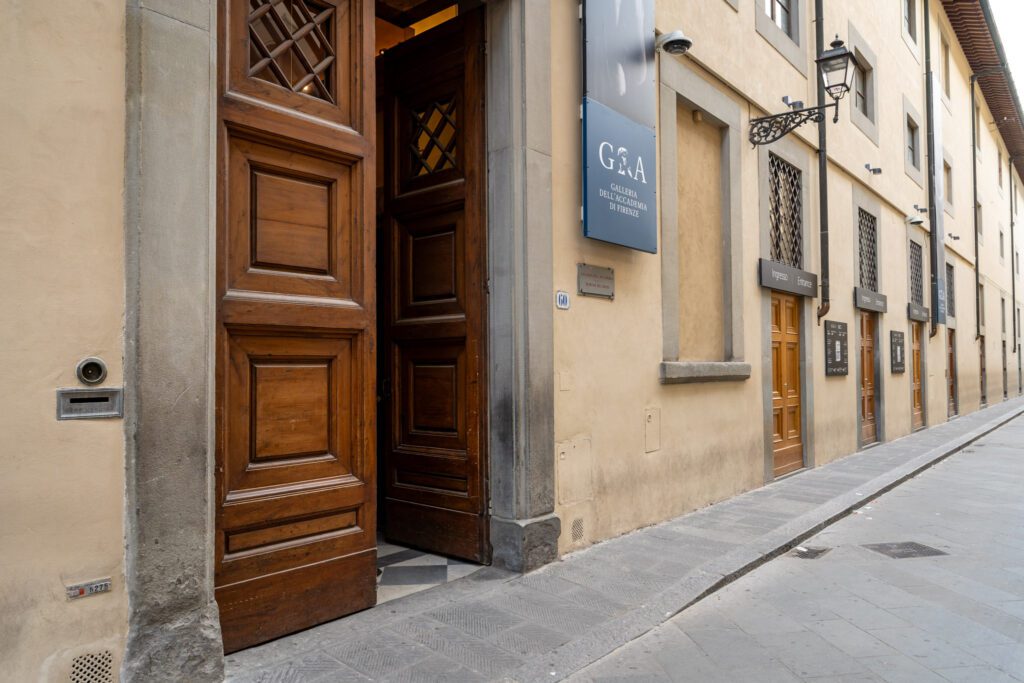
As we’ve already mentioned, the David is a masterpiece. Cut out of a single piece of marble, it stands 17 feet tall (taller because it’s elevated on a pedestal the way it’s displayed) and towers above you in the Galleria dell’Accademia (where it is now housed).
It used to be out on Piazza della Signoria, but was moved inside to protect it from the elements.
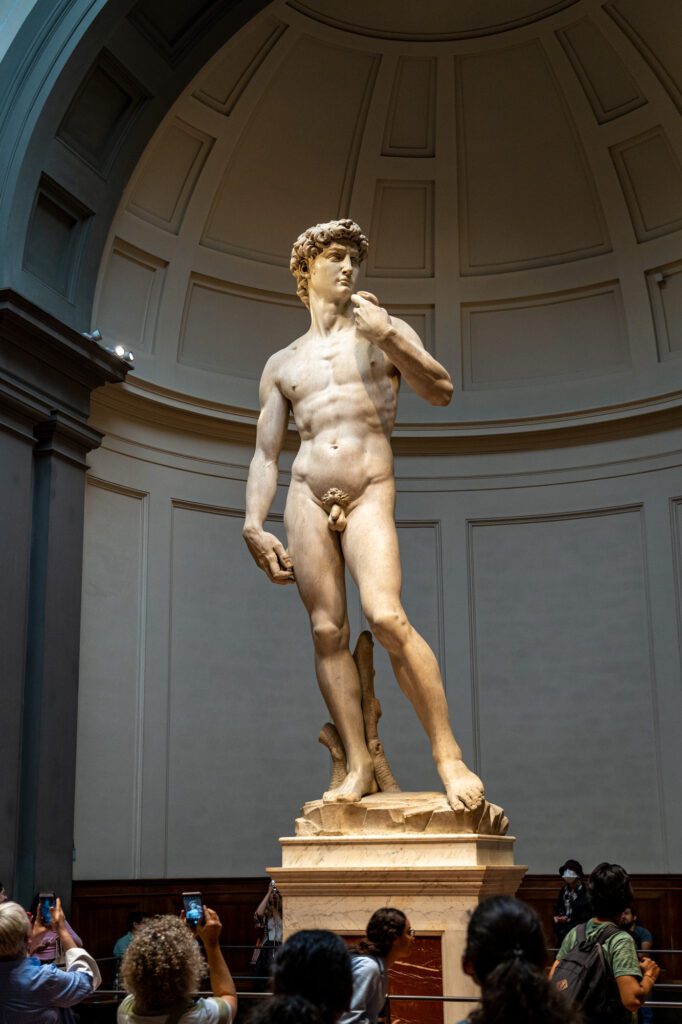
There is still a replica out on the piazza, along with another version up at Piazzale Michelangelo (which is a great view of Florence).
Many people come to this museum just to see the David, though we think it’s worth taking an extra second to stop and learn about Michelangelo’s process and how his brain worked, because I found it fascinating on my last visit.
If you’re interested in that progression and the artist’s fascination with the human body, it’s worth spending an hour or two in the Accademia (and seeing the statue in that context here, where you can walk all the way around it, is also cool).
However, if we had to choose one museum to do in Florence, we would not hesitate for an instant to point you to the Uffizi Gallery.
If you only have time or interest in one, do the Uffizi and go see the replica in Piazza della Signoria on your way in.
Book your tickets well in advance – we’re talking as soon as you know you’ll be in Florence – to avoid standing in the ticket office line (you will still have to stand in the security line), which you can do on the official website.
I’ve also done this guided tour of the gallery with my mom, which allows you to skip the long lines (and get tickets if they’re sold out through the official site) and offers a great overview of the story of Michelangelo and his career leading up to the David.
Add Another Day Trip (+1 Day)
As we mentioned, Florence is a great base for day trips to other places in Tuscany, which is one of Italy’s most famous regions with its prestigious red wines, cypress trees, and rolling green (okay, brownish gold) hills.
If you have an extra day, you could definitely do worse than adding another day trip to get out of the city and into the Tuscan countryside.
However, unless you’re doing Siena or Lucca, transportation can be tricky.
For us, the Val d’Orcia is quintessential Tuscany, but it really requires a car to do it right.
Pitti Palace and the Boboli Gardens (+2-3 Hours)
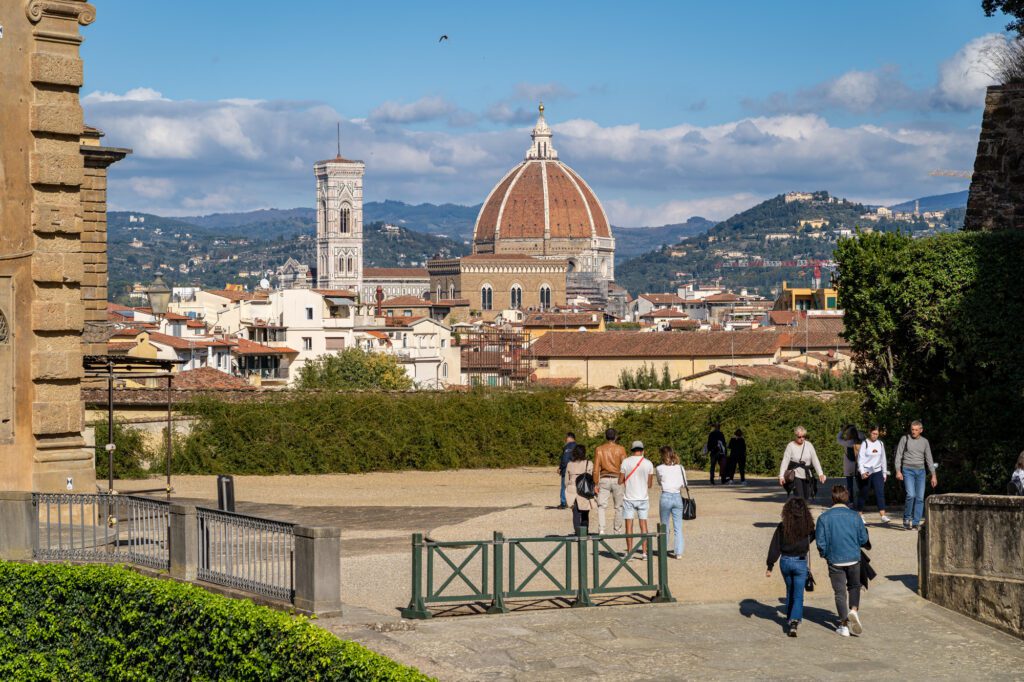
We’re not super big on visiting ornate palaces that rich people built centuries ago, so we decided to skip Pitti Palace on every single trip we’ve ever made to Florence.
However, we do love a good set of gardens (Alysha is the plant whisperer in our garden in Portland), so we have done the Boboli Gardens, which is the impressive complex attached to Pitti Palace in Oltrarno.
It’s part of the Pitti Palace Complex, but you can buy a separate ticket that is significantly cheaper and just covers the gardens.
The vast grounds span over 45,000 square meters, making them the largest green area in all of Florence. On a stroll around, you’ll discover fountains, pergolas, grottos, a small lake and hundreds of ornate Renaissance statues. A lovely way to take a break from the crowds of the busy city outside.
If you’re around in the spring or fall in particular (we’d definitely skip it in the winter, and keep in mind that it will be hot in the summer), it’s worth buying a combo ticket with the Uffizi Gallery to include a visit to the Boboli Gardens, which are beautiful and have some nice views of Florence from the grounds.
Note: The entrance to the gardens is the same as the entrance to Pitti Palace (here on Google Maps). If you’re looking at Pitti Palace, the ticket office is off to the right.
Get your tickets in advance – the ticket line can be very, very long, and you get to skip right to the front if you already have tickets.
You will still need to exchange your electronic tickets for paper tickets, though, which surprised us. Again, though, you skip the line, show a barcode, and off you go!
Learn more and get tickets here.
What to Do With Less Time in Florence
As we already mentioned above, if you only have two days to dedicate to Florence, we’d immediately cut the day trip (save it for next time!) and instead focus all of your time on Florence.
In that scenario, you can basically just follow the itinerary above as written, minus the third day.
If you only have a single day to dedicate to Florence, our first piece of advice would be to try and scrounge up at least another half day (ideally full day) so that you have more time, because we think Florence is worth it.
However, if you can’t possibly find any more time and you only have one, single day for Florence, here’s what we’d do. Start with the Duomo and climb it first thing in the morning.
Then head to the Uffizi Gallery to spend a few hours learning about the Renaissance before spending the rest of your day on the other side of the river, ending with a walk up to Piazzale Michelangelo (and the Abbazia di San Miniato al Monte) for one of the best views in Florence.
If you’re more into food, you could skip the Duomo and instead hit the Uffizi first thing in the morning and do a food tour around lunch time.
Tips for Visiting Florence
Here are a few things we think are useful to know before your trip (especially if it’s your first time in Florence), in no particular order.
Getting Around Florence
Walking is going to be your best bet in terms of getting around Florence.
On my latest trip to Florence with my mom and uncle, we did Florence after Rome, and commented almost every day that our step counts were relatively low compared to Rome because there’s just not that much ground to cover in the center of Florence.
Within the historic center, which is mostly a series of narrow streets that were a part of the original Roman city here, you functionally have no other option other than walking.
Taxis are available, but I commented multiple times that trying to get one would be a nightmare during peak hours because even at taxi stands there were usually none available (and this was in March – I can’t even imagine the summer).
If you need a taxi, the best option is going to be having your accommodations help you call one (the apps like Uber and FreeNow were useless, in my experience).
What about public transportation? Again, it’s mixed.
The historic center – the area within five to ten blocks of the Piazza del Duomo and Piazza della Signoria – is almost a public transportation dead zone.
There are a couple of the cute little short buses that run through the narrow streets but, generally speaking, the only public transit options run in a ring around that part of the city.
If you’re staying somewhere like Oltrarno or San Marco, which are on the outskirts and have wider streets and better transit connections, your public transportation options are going to be a little better (particularly in San Marco).
Here’s the official website for public transportation in Florence for more information, along with a handy Reddit thread with a mini guide to using the system.
So, taxis and public transportation can be hit or miss in the historic center, but the good news is that it basically only takes 20-30 minutes to walk between the train station and Piazza Santa Croce (which we’d call the two edges of the historic center), so walking is totally doable provided you don’t have significant mobility restrictions).
Take the Tram from the Airport
Assuming you’re flying into Amerigo Vespucci Airport (FLR) – which is both the most convenient airport for arriving in Florence AND one of my least favorite airports in the world – the best way to get to and from the city from the airport is the tram.
Line T2 leaves from just outside of the terminal at the airport and takes you to Santa Maria Novella – Florence’s main train station – in roughly 20-25 minutes flat.
It’s a fantastic airport connection, and it’s even doable if you have luggage (it’s never that packed going in that direction, except for the early morning when students are going to the university).
The best part is that it costs less than €2 Plus, you can simply tap on with a credit card (keep in mind you need one credit card per person – you can’t use one card to buy multiple tickets) when you get on, and you’re good to go!
Book Things (Namely Main Attractions) in Advance
This is especially true for the main attractions – the Uffizi Gallery, the Duomo (especially if you want to climb the dome), etc etc – which you should book as early as humanly possible. Same thing for tours.
Those things can, and will, sell out – particularly between May and September.
The thing I ran into on my last trip that I wasn’t expecting was restaurant reservations!
I had never even considered making an advance reservation before, but I learned quickly that they are necessary if there are specific places you want to eat.
I found good success booking restaurants a few days in advance in person, but if you can do it before you leave for your trip, even better (some places don’t take reservations).
Get an Early Start
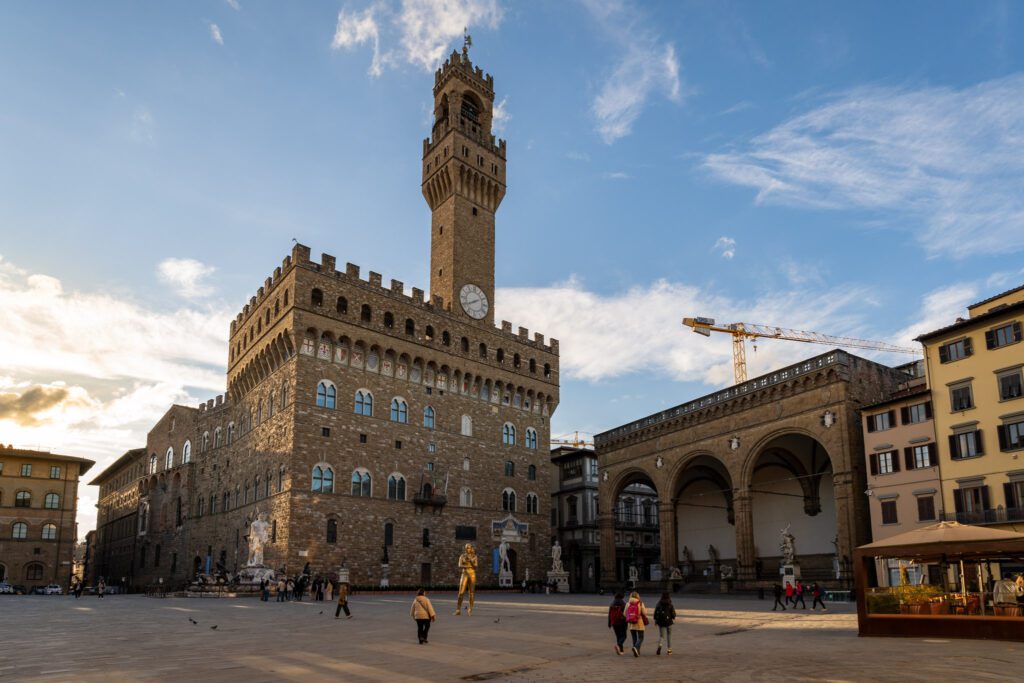
There’s no getting around it. Between the hours of 10am and 7pm (roughly), Florence is going to be busy.
I highly recommend getting as early a start as possible to maximize the amount of time you’re spending around Florence before the day trippers and other visitors get up, because it’s a magical place in the early morning.
This also extends to attractions like the Uffizi Gallery and Duomo.
On our last trips to Florence, we have done both the Uffizi Gallery and climbed the dome at the earliest possible start time AND we’ve done them later in the day, so we have a solid foundation to compare the two experiences.
Both were great at 8am, when we were not the only people there, but there were noticeably fewer people (particularly in the museum).
By the time we left the museum, around 11am, it was jam-packed and was far less pleasant.
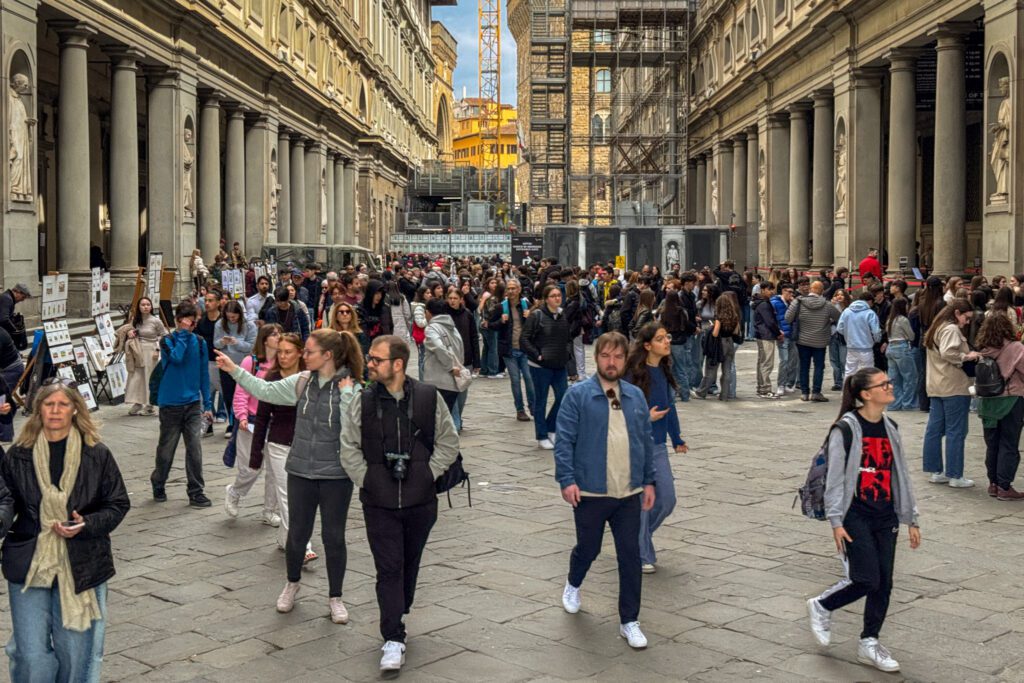
I know it sucks to wake up early on vacation, but we think it is absolutely worth it.
Learn Some Basic Words and Phrases in Italian
It’s often easy to forget that English isn’t people’s first language, because many Italians (especially those working in tourism) speak really good English, but you’ll have better interactions if you greet people in Italian and use a few key Italian phrases.
I’ve been (sort of) learning Italian, and being able to do basic things like ordering coffee or dinner in Italian has made a huge difference, and will almost always lead to a more positive interaction.
Here is the list that I’d become familiar with, including a mini pronunciation guide.
- Hello – “buongiorno” (bone-jore-no) if it’s before 1-2pm, “buonasera” (bwone-ah-sarah) if it’s after 1-2pm
- Please – “per favore” (pair fah-vore-ay)
- Thank you – “grazie” (grah-zee-eh, though the last syllable changes depending on where in Italy you are)
- Goodbye – “ciao” (chow, but it’s better if you say it twice in a row!)
- Do you speak English? – “Parla Inglese?” (Par-lah Een-glay-zay)
- The bill/check please – “Il conto, per favore” (eel cone-tow pair fah-vore-ay)
- Where is XXX – “Dov’è XXX” (dough-vay XXX)
- I would like XXX / We would like XXX – “Vorrei / Vorremmo” (Vore-ay / Vore-ay-moe)
Make sure to always start any interaction with a greeting (buongiorno or buonasera, depending on the time of day), which is something that we as Americans don’t always think about, but is a must when you’re visiting Europe.
Eat as the Locals Do!
I’ve rewritten this section several times now in order to make sure I’m communicating the right thing in the right way here, and I hope you don’t see this as a lecture.
I’m legitimately trying to help you have the best possible experience in Florence.
I’ve had a similar experience in multiple cities around the world that goes something like this: I’m walking down a street in a major tourist destination and see a huge line – complete with stanchions and security guards – outside of a place that looks like it was carefully crafted to get famous on Tik Tok.
And, sure enough, the common denominator is usually a viral Tik Tok video. And also that the place in question often has very little to do with the local food culture.
On my latest trip, I asked a fellow visitor what the best thing they’d eaten in Florence (my favorite question to ask everyone!) and they responded with a description of a dish that I can only describe as fettuccine alfredo that is made in a wheel of cheese?
I had to forcibly stop my eyes from rolling to avoid being rude, because I was aware of this trend on Tik Tok, and also knew that it was about as far from traditional Tuscan food as it gets.
Part of learning and immersing yourself in a different culture (even for just a few days) is exploring the food scene and Florence (and broader Tuscany) is such a rich food culture that I truly believe it would be a shame to miss out on that.
All that is to say that you should be discerning about what you’re eating in Florence, because it’s an incredible food city and there is so much delicious pasta, bread, meat, cheese, and wine to be had that you could spend an entire lifetime here and never run out of delicious things to eat.
Now, I have Celiac Disease, which means dining out is generally more complicated for me (you can read my gluten free guide to Florence for my favorite gluten free spots in the city), but I still have done my best to explore the food scene in Florence as best I can.
Here are a few things I think you shouldn’t miss based on my experiences:
- Pappa al pomodoro: A delicious “bread soup” made with stale bread and tomatoes that is often served as a starter.
- Anything with “cinghiale”: Wild boar is one of my favorite discoveries over the past few trips to Italy, and my favorite preparation is as a stew or a pasta sauce (usually served with pappardelle.
- Vinsanto: A sweet, butterscotch-y dessert wine served with dessert. There’s a specific dessert – cantucci con vin santo – where you’re given little biscotti to dip into the wine.
- All of the Filled Pasta: While I associate filled pasta like tortellini with Bologna more than Florence, it’s clearly a staple in Florence’s food scene. I like them filled with spinach and ricotta and tossed in a brown butter sage sauce (which is a dish I make at home fairly often now).
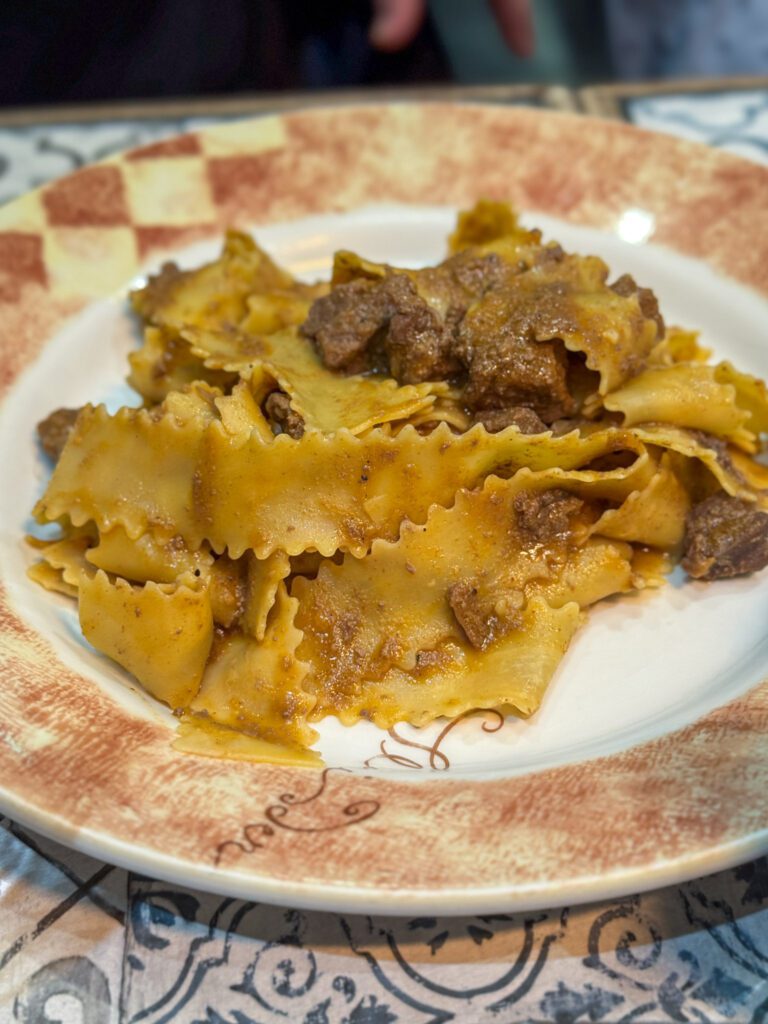

For more about what/where to eat in Florence, I highly recommend heading over to Curious Appetite.
Coral is a food writer based in Florence, and I trust her opinions on where to eat (and where not to) around the city. She has tons of guides about where to find the “best” version of specific foods.
She also runs food tours, which would be an excellent way to get a level deeper and get some expert advice on what to eat and where to eat it.
Planning a trip to Italy? We’d love to help!
Here are our other Italy travel guides to help you plan an incredible trip (even if you have to eat gluten free!).
If there’s no link below, it means we’re still working on it – long, in-depth guides take time! We’re working on it, though, we promise.
If you’re planning a trip and you’re not sure where to start, your first stop should probably be one of our detailed itineraries.
We have a two week Italy itinerary that blends the main cities with some less-visited cities that we love (BOLOGNA!), a guide to spending 10 days in Italy that focuses mostly on the highlights, and a whirlwind guide to spending one week in Italy that features the Rome – Florence – Venice highlight circuit.
We also have a guide covering important tips for traveling to Italy for the first time, which is a collection of things we’ve learned over the course of our time in Italy that will help you have a smoother, more immersive trip.
Here are more specific guides to the main cities in Italy.
Rome
- What to do in Rome (as a First Timer)
- How to Plan an Amazing 4 Day Rome Itinerary
- Where to Stay in Rome: A Complete Guide for First Timers
- 26 Things to Know Before You Visit Rome
- Gluten Free Rome: A Complete Guide to GF Restaurants + Bakeries
- Where to Find the Best Specialty Coffee in Rome
Florence
- What to do in Florence (as a First Timer)
- How to Plan an Amazing Florence Itinerary (3 Days)
- Where to Stay in Florence: A Complete Guide for First Timers
- Gluten Free Florence: A Complete Guide to GF Restaurants + Bakeries
- Where to Find the Best Specialty Coffee in Florence (for Coffee Nerds)
- The Best Day Trips from Florence (Complete Planning Guide)
Venice
- A Perfect 3 Day Venice Itinerary (for First Timers)
- Exactly What to Do in Venice (As a First Timer)
- Where to Stay in Venice: A Complete Guide
- Gluten Free Venice: A Complete Guide (for Foodies)
Bologna
- What to do in Bologna (as a First Timer)
- How to Spend One Incredible Day in Bologna
- How to Plan an Amazing Bologna Itinerary (2 Days)
- Where to Stay in Bologna: A Complete Guide for First Timers
Cinque Terre
- What to do in Cinque Terre (as a First Timer)
- How to Plan an Amazing Cinque Terre Itinerary (2 Days)
- Where to Stay in Cinque Terre: A Complete Guide for First Timers
Milan
- What to do in Milan (as a First Timer)
- How to Plan an Amazing Milan Itinerary (2 Days)
- Where to Stay in Milan: A Complete Guide for First Timers
- Gluten Free Milan: A Complete Guide to GF Restaurants + Bakeries
The Rest of Italy

I really enjoy your blog, mostly because you inject your personal observations and experience and very importantly you impart important gluten free information. That is priceless! Just wondering how you made out at Mercato Centrale in finding gluten free food. Was it easy? Available?